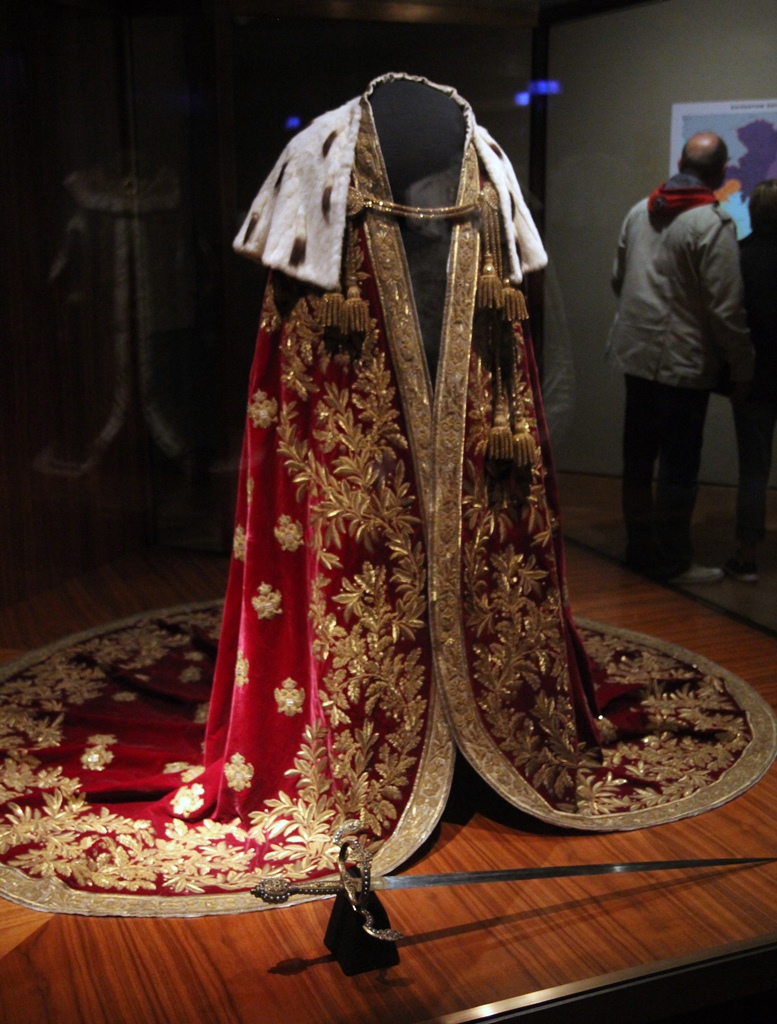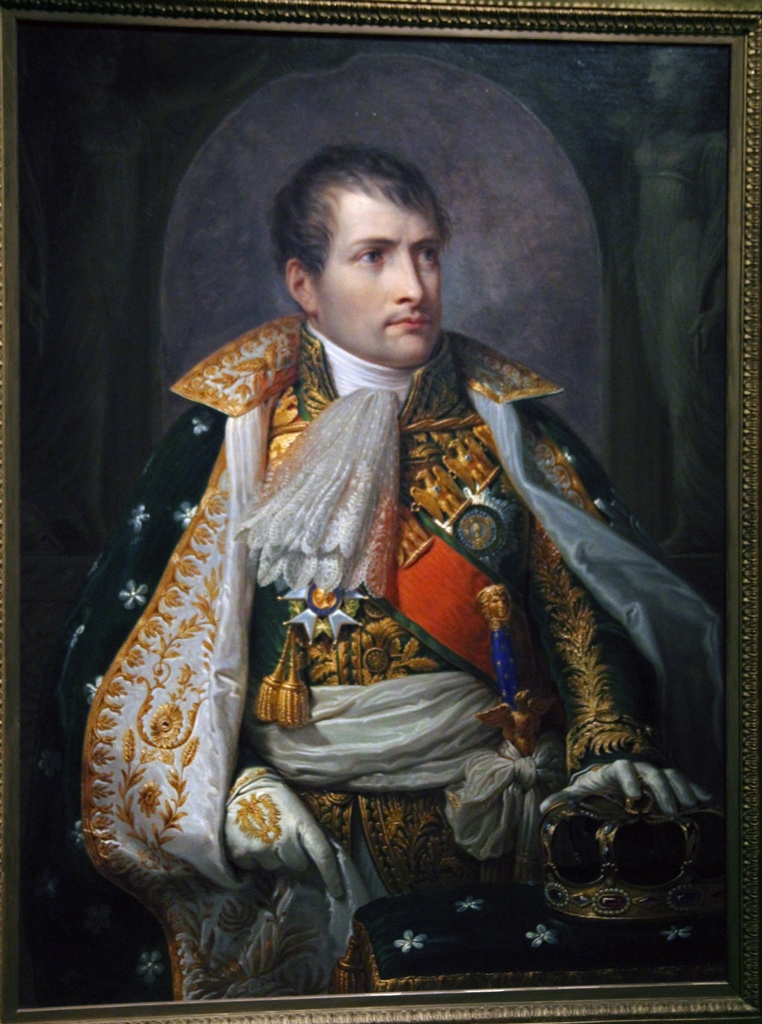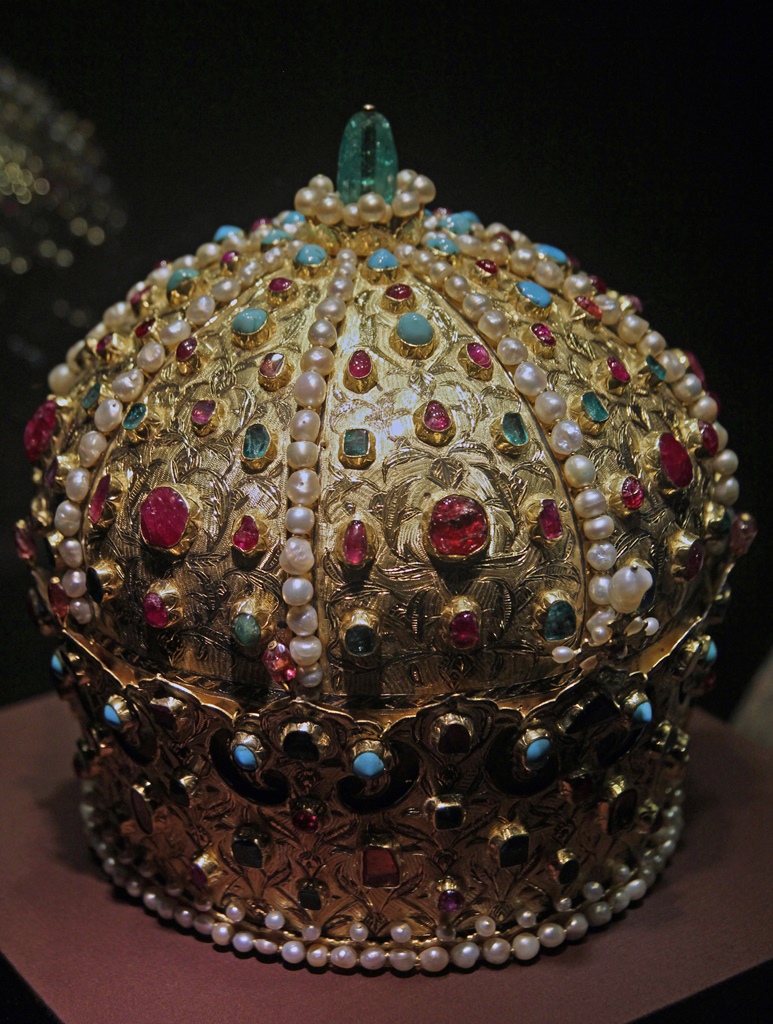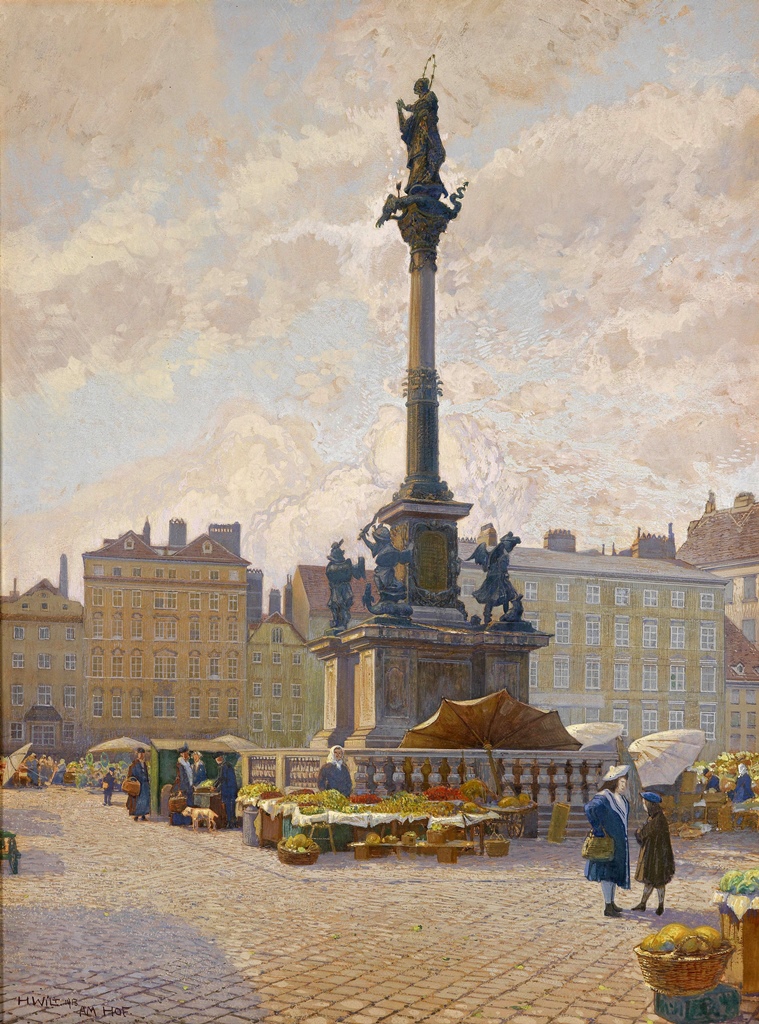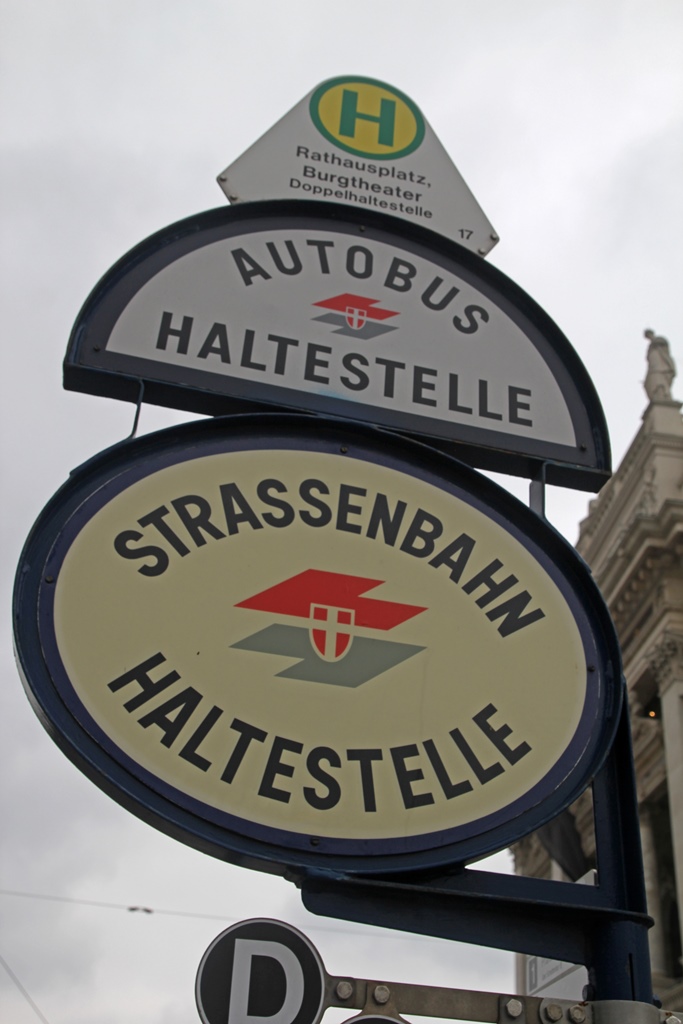Vienna's Imperial Treasury,
or Kaiserliche Schatzkammer (Schatzkammer for
short), is a collection of rare and valuable artifacts, amassed by the House of
Habsburg over centuries and representing more than a thousand years of European
history. It's kept in the oldest part of the Hofburg palace complex, a section
called the Schweizerhof, or "Swiss Court". The Schweizerhof was built in
its original form by the Babenburger family in the 13th Century, when it took the
form of a square castle with four turrets, surrounded by a moat with drawbridge.
Its current appearance dates back to a 16th Century remodeling by Emperor Ferdinand
I. A 15th Century chapel called the Hofburgkapelle is also found in this
part of the palace, and is the venue where the famous Vienna Boys' Choir
traditionally sing Sunday masses.
But we only had eyes for the Schatzkammer, so after breakfast we again headed for
the Hofburg by way of our usual route, down Kohlmarkt. The street ends at the large,
roundish Michaelerplatz, where one can turn in any of a few directions (the previous
morning in the rain we had turned left, toward the Albertina Museum), but on this day
we were going straight. We would be entering the Hofburg through a portal in the
massive St. Michael's Wing of the palace, directly beneath a large green dome. But
first we looked more closely at the Michaelerplatz face of the St. Michael's Wing.
There was some renovation work going on, with scaffolding, but we were able to get a
look at some of the statues facing the square. There were allegorical statues
representing the empire's sea and land power (though the sea power in particular was
never much to brag about) and other statues depicting some of the labors of Hercules.
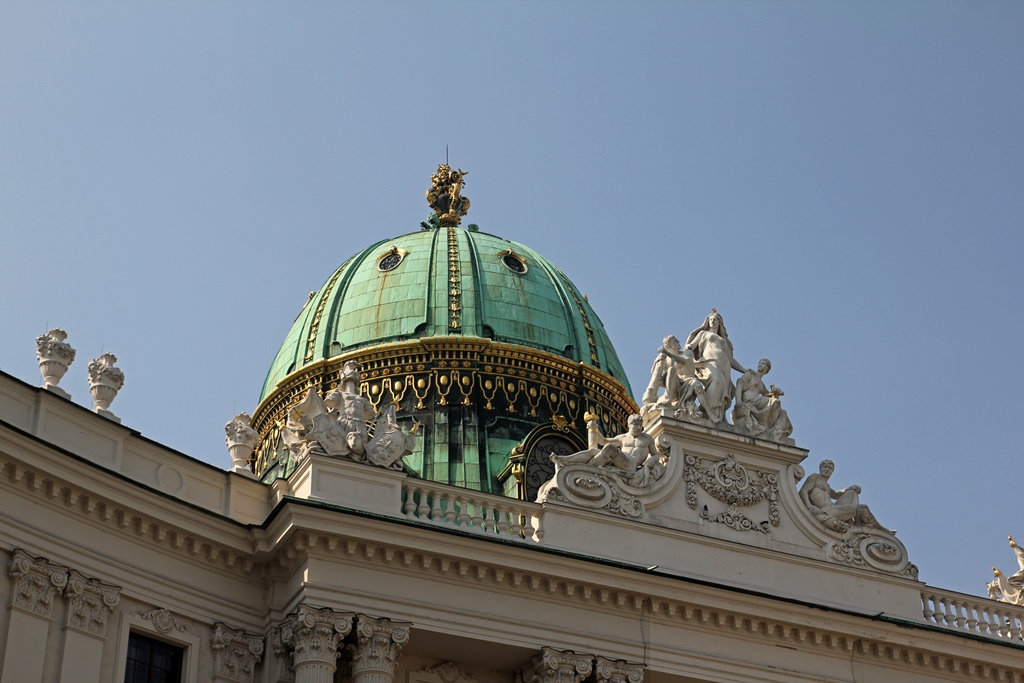
St. Michael's Wing Dome
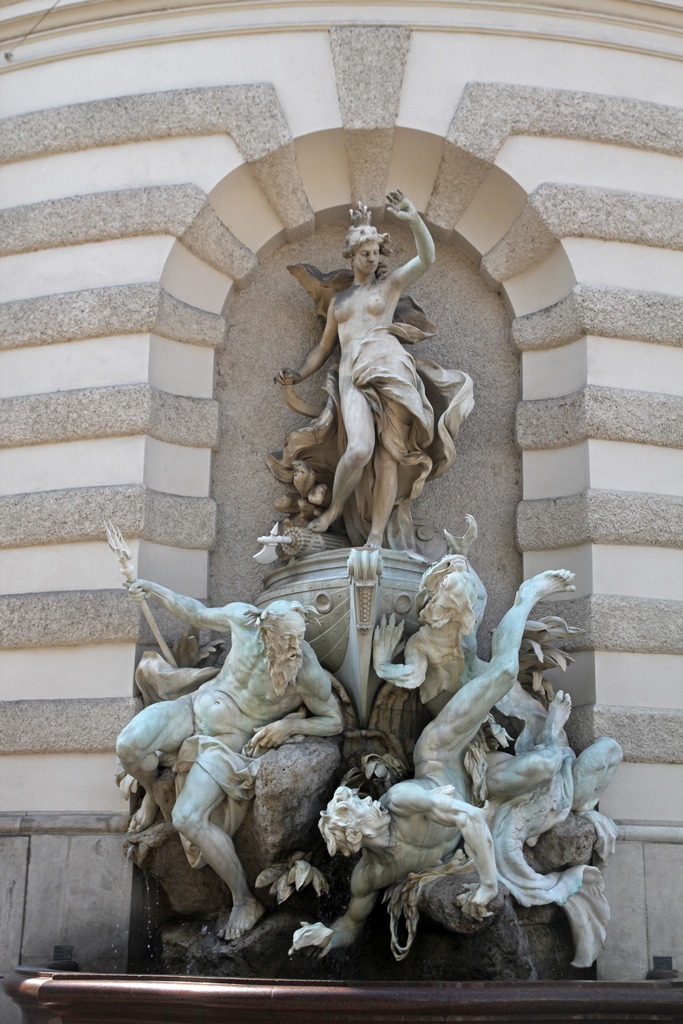
Michaelerplatz Statue - Sea Power
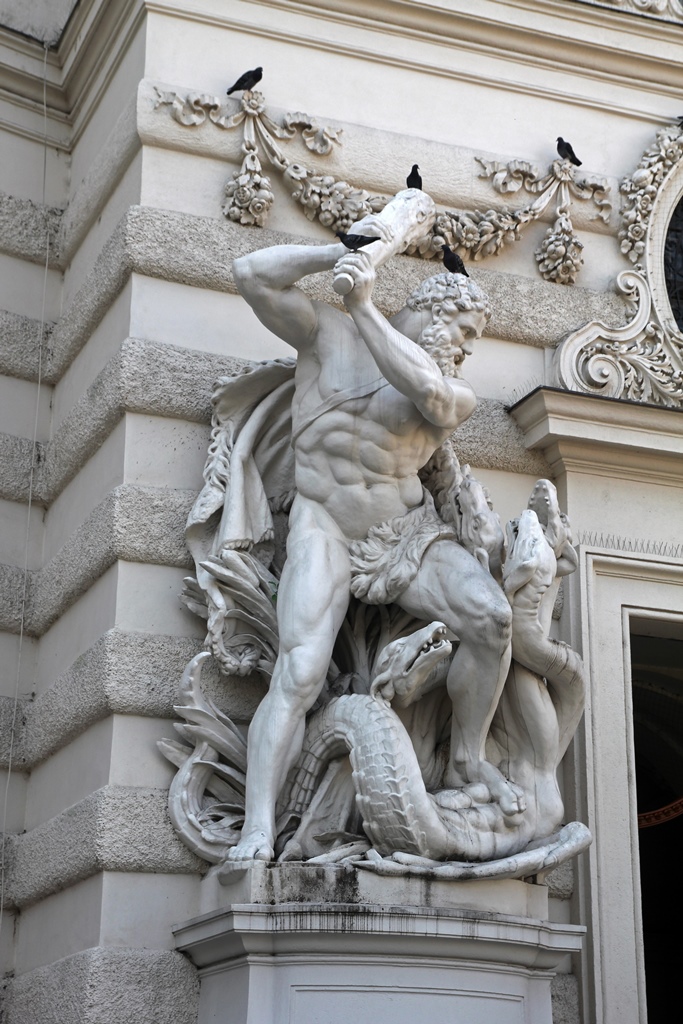
The 2nd Labor of Hercules - Slaying the Lernaean Hydra
Passing through the doorway and the St. Michael's Wing, we entered a courtyard
called In der Burg. The entrance to the Schweizerhof is one of the exits from
In der Burg, but before taking it we again paused to look at our surroundings.
The centerpiece of the courtyard, covered by scaffolding during our visit, is a
monument to Francis I, husband of Maria Theresa and the first Lorraine ruler.
The three buildings surrounding the courtyard that are not the Schweizerhof are
the Amalienburg, the Leopoldine Wing and the Imperial Chancellory Wing. The
oldest of these buildings is the Amalienburg, across from the Schweizerhof,
which was built as a standalone imperial residence. The Leopoldine Wing is the
building on the left from the Schweizerhof. It was built to connect the
Schweizerhof with the Amalienburg, and seems to have always been used for
government purposes. Even today, the offices of the Austrian President are
located in this wing. The building on the right, the Imperial Chancellory Wing,
was initially used for offices of the Holy Roman Empire, and after its
dissolution in 1806, was converted to apartments for the use of the royal family.
It first resident was Napoleon Bonaparte, and by the middle of the 19th Century
was occupied by Emperor Franz Joseph and the Empress Elisabeth. This wing is
open to visitors (we did not get a chance to visit), who in addition to some of
the apartments can see a display of the royal silver collection and
a museum
devoted to Elisabeth, popularly known as Sisi.
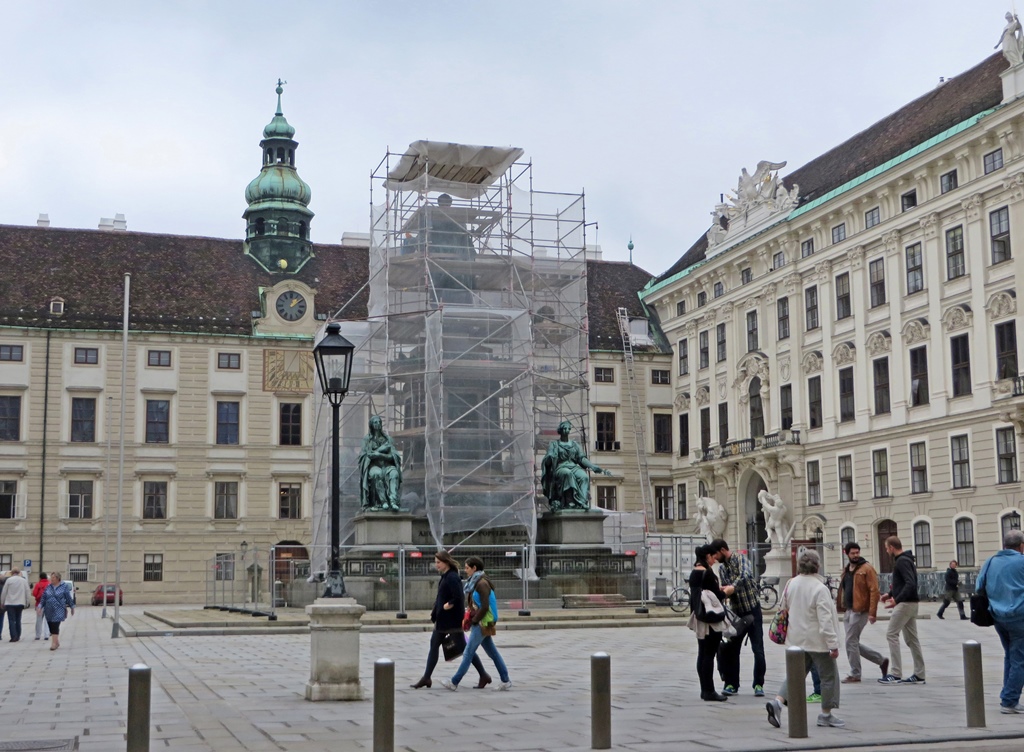
In der Burg Courtyard
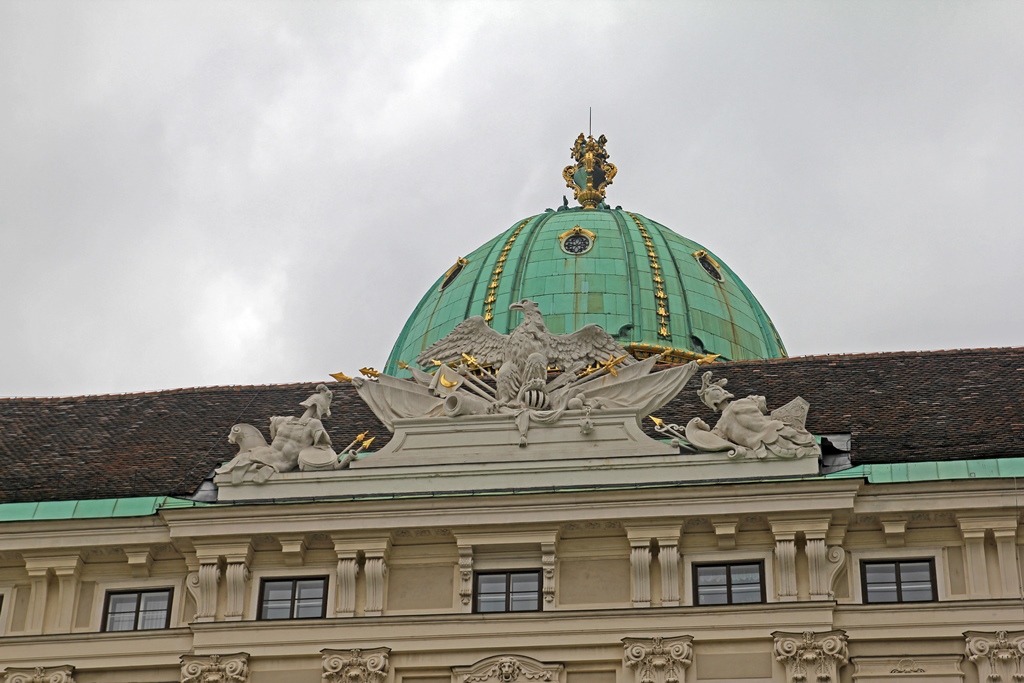
Imperial Chancellory Wing and Dome from In der Burg
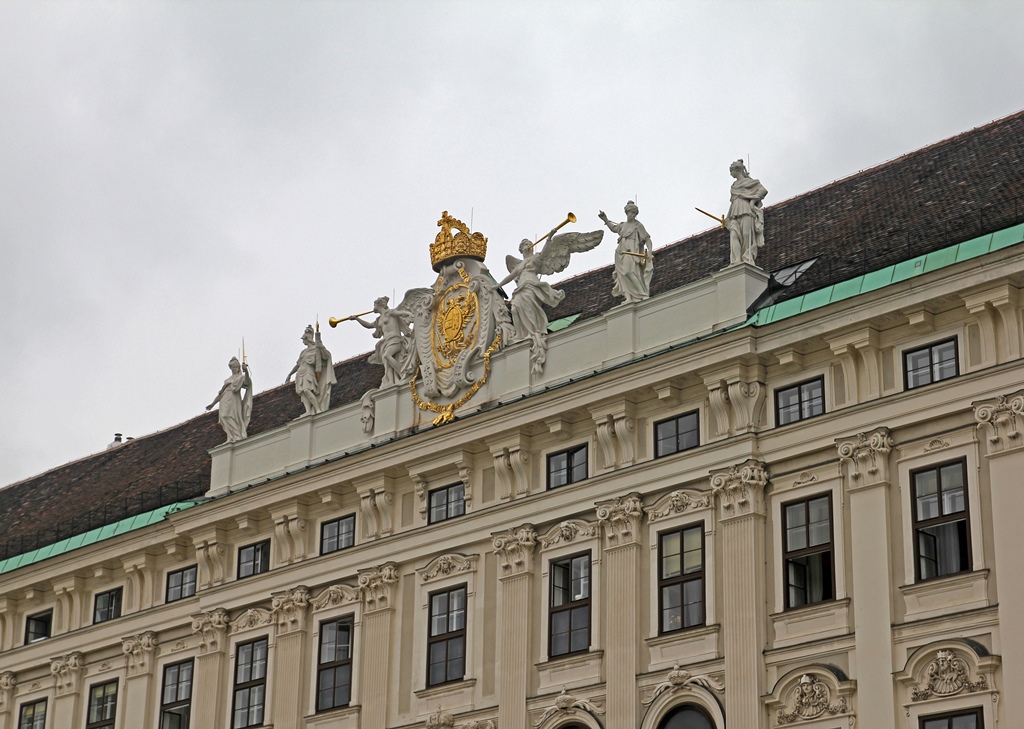
Chancellory Wing Detail
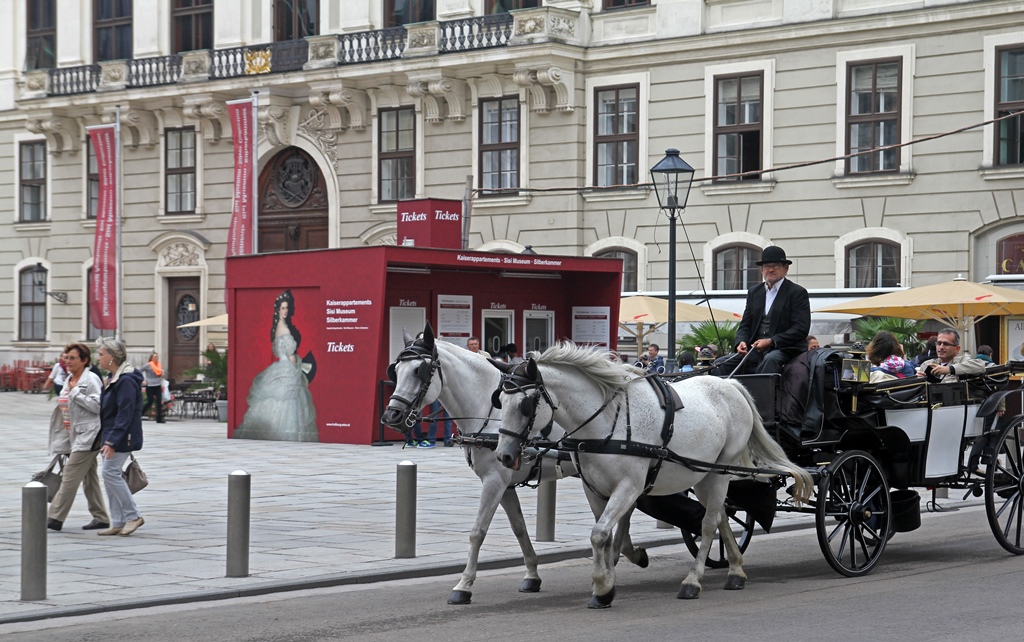
Carriage and Sisi Museum Ticket Office
In Vienna there is something of a cult of personality surrounding Elisabeth, who
lived a life characterized by vulnerability, uncomfortable celebrity and tragedy.
A number of women over the years have generated similar interest among the public,
two more recent figures that come to mind being Princess Diana and Marilyn Monroe.
But more than a century after her death, people are still writing books about Sisi,
taking "Sisi Tours" and buying souvenirs with her image. If you travel to Vienna,
you're bound to run into Sisi depictions and attractions. The Hofburg being her
main residence in Vienna, this seems as good a place as any to insert a brief
discussion of her life.
In 1853, Princess Sophie of Bavaria, the domineering mother of young Austrian
Emperor Franz Joseph, decided that it was time her son become married, and that he
should become married to her sister Ludovika's eldest daughter Helene, whom he had
never met. A meeting was arranged at which Franz Joseph was expected to propose
to Helene, but things didn't go according to plan. The meeting between Franz
Joseph and Helene demonstrated an utter lack of chemistry between the two cousins.
This was not usually considered an insurmountable problem when royal matchmaking
was concerned, but to the surprise of everyone, a ready alternative presented
itself: Franz Joseph found himself smitten with Helene's 15-year-old sister
Elisabeth, who had accompanied her mother and sister to the meeting. This was not
the plan, and the moms weren't at all happy with the idea of Franz Joseph marrying
Elisabeth instead, but Franz Joseph for once stood up for himself and insisted.
Sophie relented and Elisabeth said yes to the proposal, and the marriage making
Elisabeth Empress of Austria at the age of 16 took place at Vienna's
Augustinerkirche in 1854. Helene was disappointed, but she was eventually able to
marry Maximilian, Prince of Thurn.
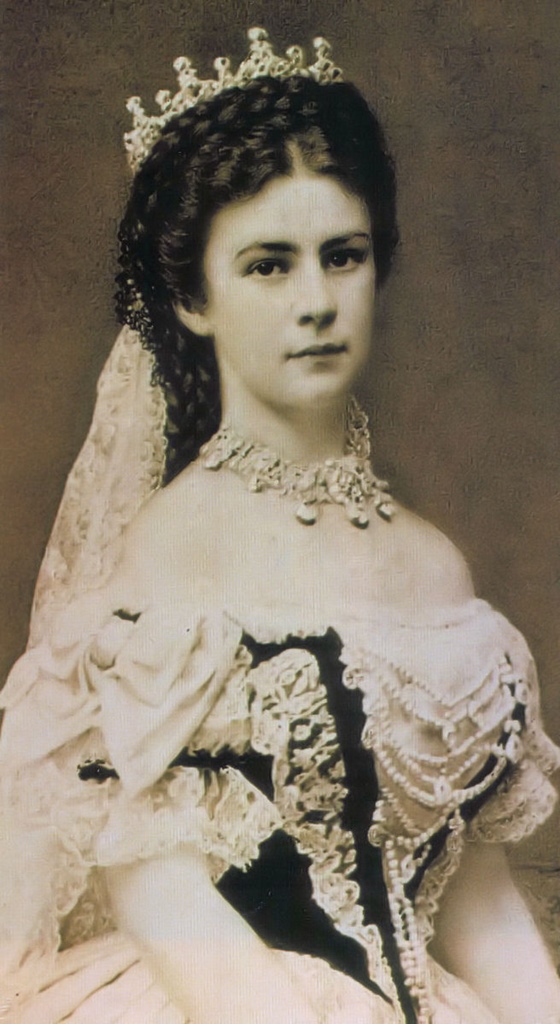
Empress Elisabeth at Coronation, 1854
Elisabeth at first did what was expected of her, giving birth to children in both
1855 and 1856. But things were not going as well as one would hope. For one thing,
both children were girls, and consorts of Emperors were expected to produce crown
princes. Giving birth to girls only was seen as a failure on the part of the mother.
Also, her mother-in-law did not allow her to raise her own children, taking complete
charge of them and even naming the first child Sophie after herself. Elisabeth was
also unhappy with the Empress lifestyle. She had grown up in the Bavarian House of
Wittelsbach (her favorite cousin later became "Mad" King Ludwig II, eccentric builder
of fairytale castles), where court life was apparently not as stiffly formal as it
was at the Hofburg. She was also introverted by nature, and did not look forward to
participating in court proceedings (she even developed illnesses which have been
thought to be at least partly psychosomatic). In 1857 she visited Hungary with her
husband and children, and found Hungary to be much less formal and more to her liking.
Her affinity for Hungary was reciprocated by the Hungarians (those of you who have
read through the Budapest pages may recall there are a bridge and a square named after
her), and she made a long-term effort to try to learn Hungarian. But the trip also
had sad consequences, as her children both became ill (probably from typhus), and
two-year-old Sophie ended up dying from it. The other daughter, Gisela, survived, but
her mother went into a depression in which she neglected Gisela, and a mother-daughter
relationship never really developed. But Elisabeth was able to become pregnant again,
giving birth in 1858 to a son named Rudolph, who immediately became his father's heir
apparent. This event was celebrated by all of Austria, and Elisabeth's influence at
court increased as a result. She had become interested in using some of this
influence, particularly in acting as an advocate for Hungarian interests. She is
thought to have been an important factor in the eventual Austro-Hungarian Compromise
of 1867, which created the dual monarchy of Austria-Hungary. This granted Hungary
more autonomy, but also made Franz Joseph and Elisabeth the King and Queen of Hungary.
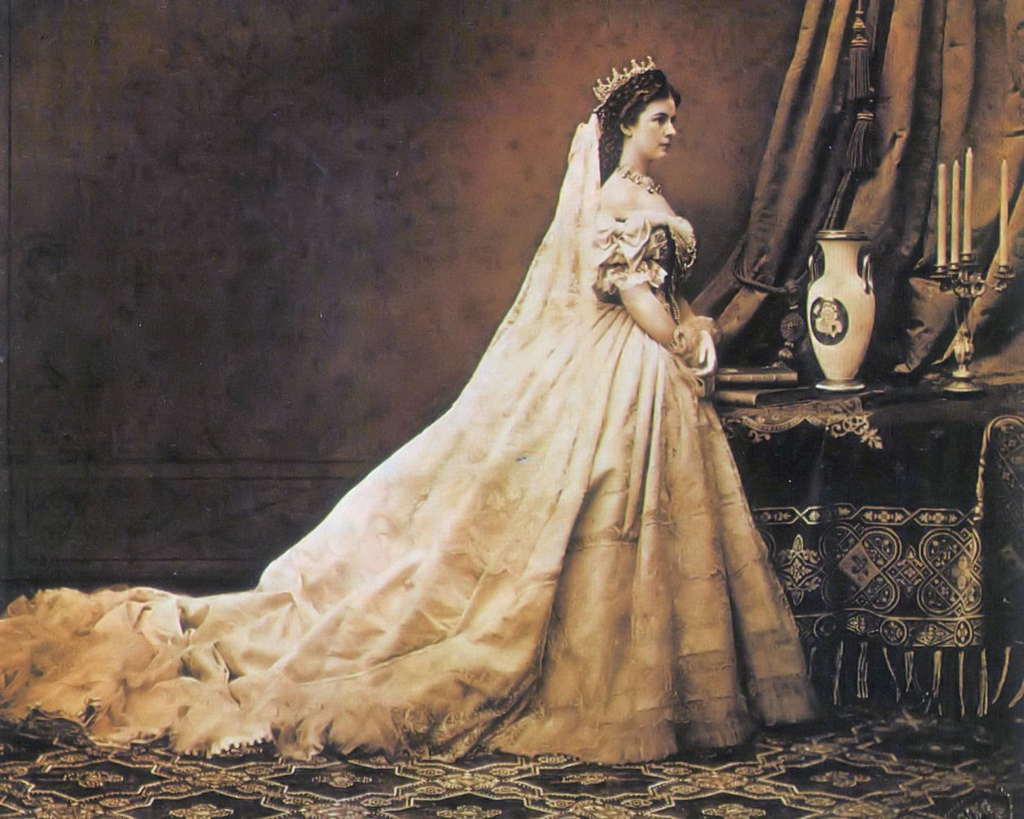
Empress Elisabeth at Hungarian Coronation, 1867
During this time, the marriage of Elisabeth and Franz Joseph had become distant.
Franz Joseph continued to adore his wife, but Elisabeth's ardor for the emperor
faded considerably, possibly exacerbated by her depression following the death of
Sophie. It's thought that part of the negotiation for the Austro-Hungarian
Compromise was a commitment by Elisabeth to make an attempt at resurrecting the
marriage. This, together with a desire on Elisabeth's part for another child, led
to the birth (in Budapest) of another daughter, named Marie, in 1868. Elisabeth's
increasing influence in Vienna took place during a corresponding decrease in
influence of the elder Sophie. This meant that Elisabeth was free to lavish her
maternal instincts upon Marie, which she did, possibly to excess. Sophie
eventually died in 1872. But again Elisabeth could not find happiness in her
marriage, and she began a life of travel, which she enjoyed considerably more.
She did not dislike her husband, and in fact encouraged his relationship with an
actress named Katharina Schratt during her absences, so he wouldn't be lonely.
This routine went on for several years, but the relative happiness of the
dysfunctional family was shattered in 1889, when Crown Prince Rudolph was found
dead at a hunting lodge in the Vienna Woods, part of an apparent suicide pact with
his mistress, Baroness Mary Vetsera (possibly because Franz Joseph had been
insisting that Rudolph break off the relationship). This was obviously
devastating to the family, and to the country, and was probably the worst blow to
Elisabeth, who was in the midst of a few years in which she was to lose many of
those closest to her, including also her father (1888), her mother (1892), her
sister Helene (1890), and probably her closest friend, Count Gyula Andrássy of
Hungary (1890). She reacted by shifting her travel activities into overdrive, no
doubt attempting to distract herself from things. But her correspondence with
her husband actually increased during this time, and it's apparent that their
relationship had become a warm friendship. This all ended on a September day in
1898 when, while walking to catch a steamship on Lake Geneva, she was stabbed to
death by an anarchist. She was 60 years old, a good long life by 19th Century
standards, but death by murder is always premature. The reaction of the Viennese
public was more extreme than the one that followed the death of Rudolph. Besides
the shock and sadness, there was anger, and when it became known that the
assassin was Italian, there were those who called for violence against Italians.
Sisi was buried in the Kaisergruft in Vienna, near her son Rudolph. Franz
Joseph, who died in 1916, now occupies a tomb between them.
Throughout her life, Elisabeth was very aware of her beauty and the public's
perception of it, and went to great lengths to maintain it. She may have felt
this was one aspect of her life where she had a certain amount of control, while
this was not always true about the events surrounding her. She always wore her
hair very long (reaching the ground), so long that she complained about the
headaches that sometimes occurred due to its weight. She employed a hairdresser
who accompanied her on her travels, who would spend hours each day grooming the
hair and weaving it into elaborate hairstyles. Elisabeth was also obsessive
about her waistline, and her clothing (when she wasn't pregnant) consistently
measured less than 20 inches around the waist. This was partly accomplished
through undergarments which must have been extremely uncomfortable, but she also
followed a vigorous exercise regimen (mostly gymnastics and horseback riding).
Her diet could only be called peculiar, with periods of binge eating (she was
apparently fond of things like Sacher tortes) and of fasting, and modern-day
doctors might diagnose her as having an eating disorder. She took measures to
maintain her skin tone, but was not a big user of cosmetics or perfume. After
passing the age of 32, she no longer posed for portraits or photographs, wanting
to maintain the mystique of eternal beauty. And judging from the 21st Century
fascination with her, she seems to have largely succeeded.
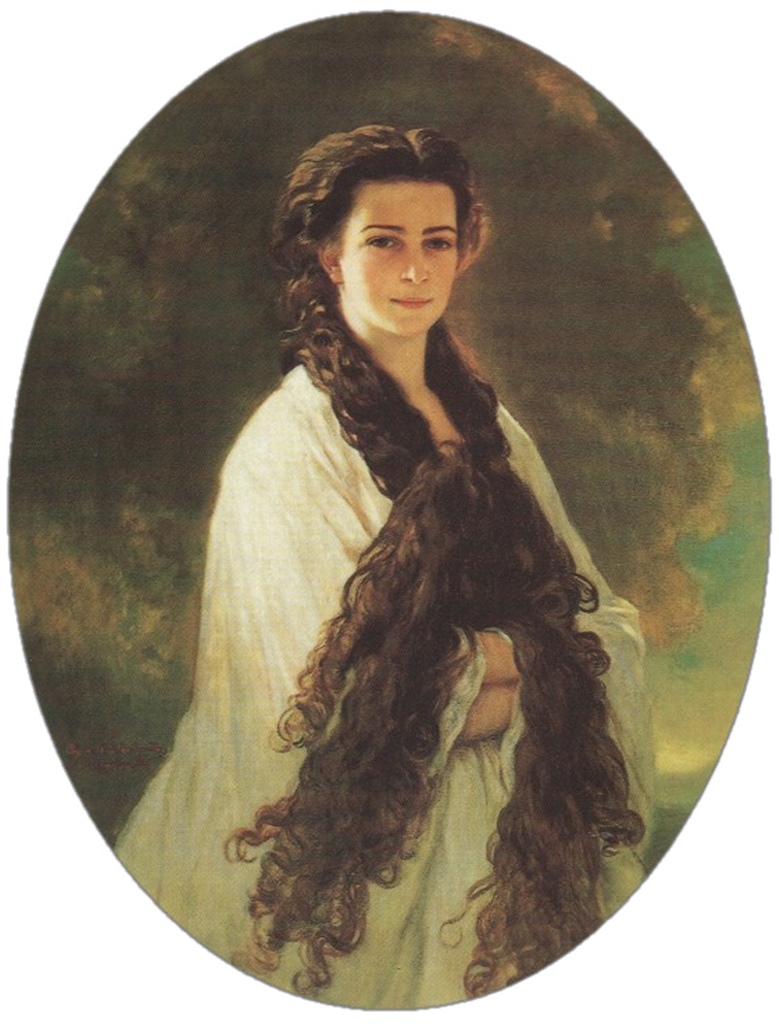
Empress Elisabeth, 1864 (age 27)
But back to In der Burg. The Schweitzerhof, home to the Schatzkammer,
occupies the southeast face of In der Burg, and is entered through a 1552
archway called the Schweitzertor. Choosing the wrong archway is
difficult, as the walkway through this one is flanked by two railings with
"Schatzkammer" spelled out in big, shiny metal letters.
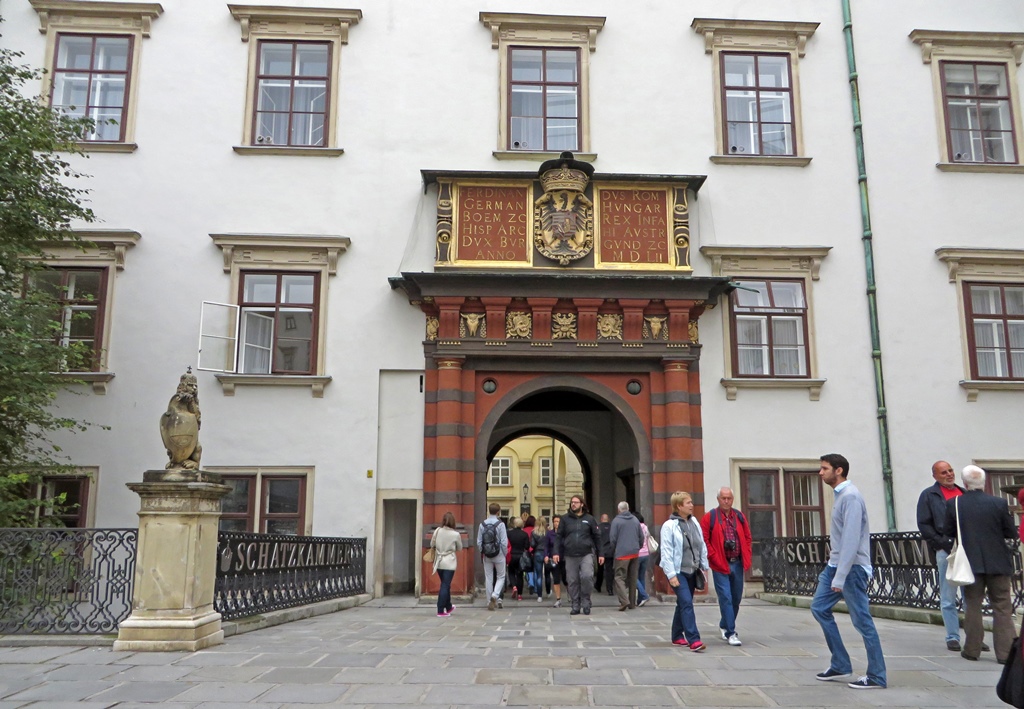
The Schweitzertor
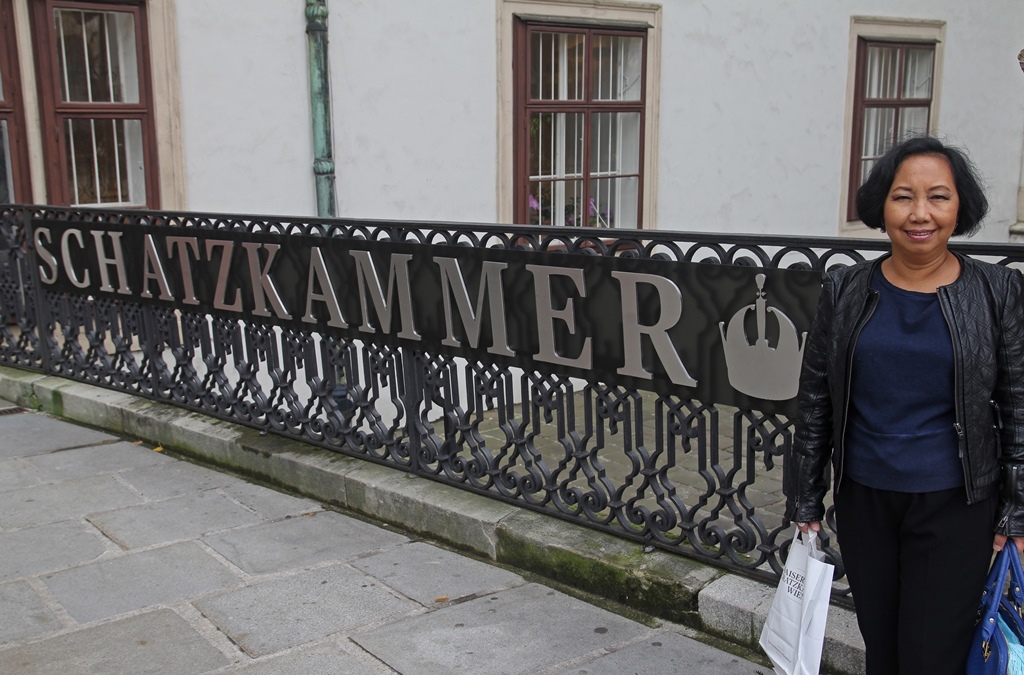
Nella at Schweitzerhof Entrance
Once in the Schweizerhof courtyard, the Schatzkammer entrance is to the right. The
Schatzkammer is affiliated with the
Kunsthistorisches Museum,
which we had visited the day before, and combination tickets that include both
museums (and three additional museums, in the Neue Burg) at a discount are
available. We'd planned ahead and bought combination tickets at the
Kunsthistorisches Museum, so we only had to show them at the Schatzkammer to gain
entry.
The first major exhibit to be seen was the Imperial Crown of Austria, made in 1602
for Holy Roman Emperor Rudolph II (and sometimes referred to as the Crown of Rudolph
II), and the accessories (scepter and orb) that go with it. This crown was used as
a "private crown" by Holy Roman Emperors. There was also an official Crown of the
Holy Roman Empire (see below), but it was kept in the city of Nuremberg, and was
only allowed to leave the city for coronations. When the Austrian Empire was
created in 1804, the Crown of Rudolph II became its official crown. The orb and
scepter were made between 1612 and 1615 to match the crown. The shaft of the
scepter was said to be made of unicorn horn, but was really made from the horn of a
narwhal (a common stand-in for horns of unicorns, which were unfortunately mythical).
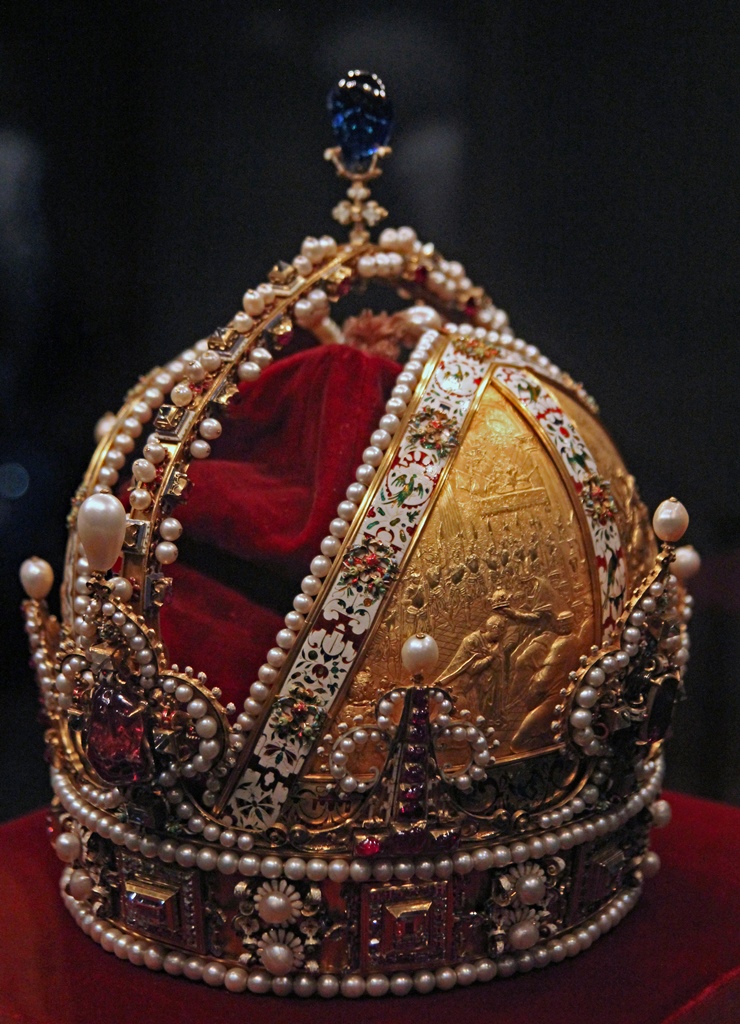
Crown of Rudolph II (1602)
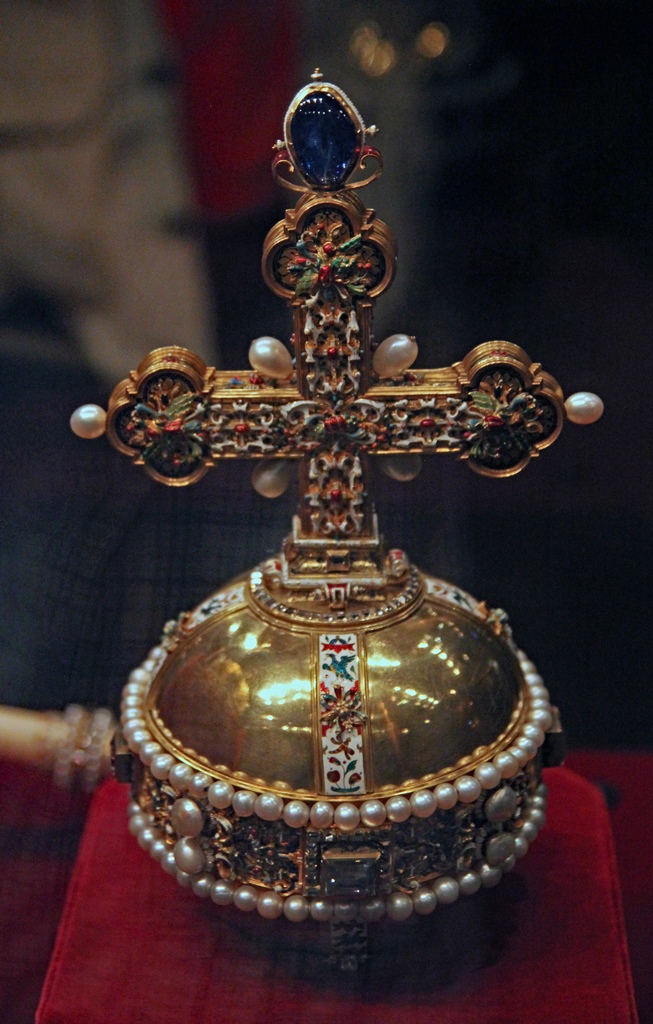
Imperial Orb to Match Rudolph II Crown (1612-15)
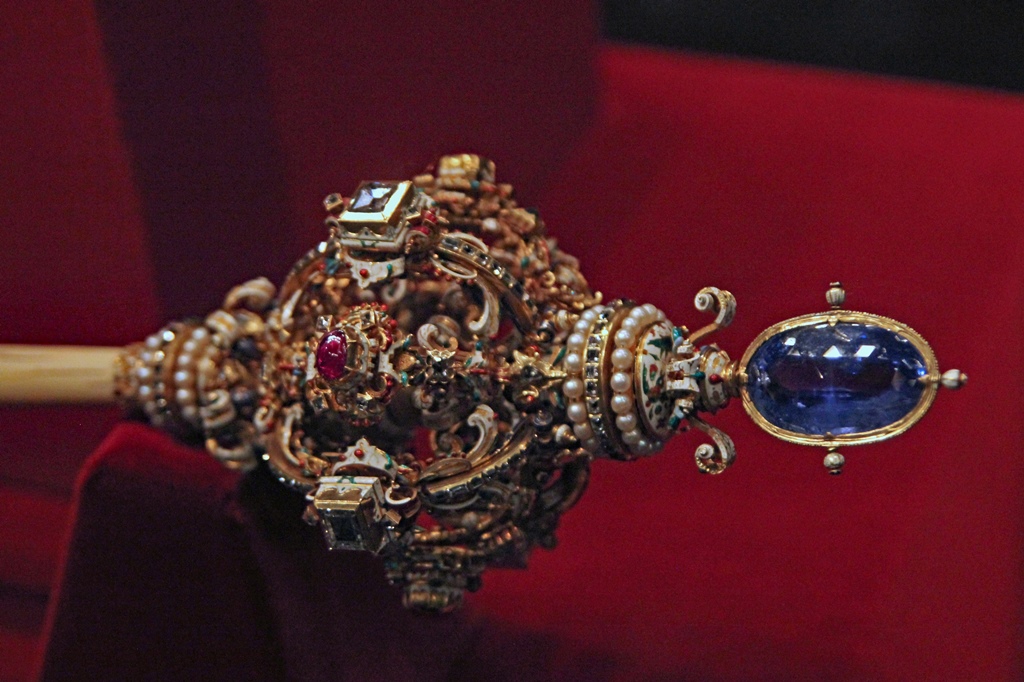
Sceptre Made for Emperor Matthias (1615)
Following the crown and regalia exhibit, there were a number of displays of ceremonial
clothing.
Mantle of the Austrian Emperor (1830)
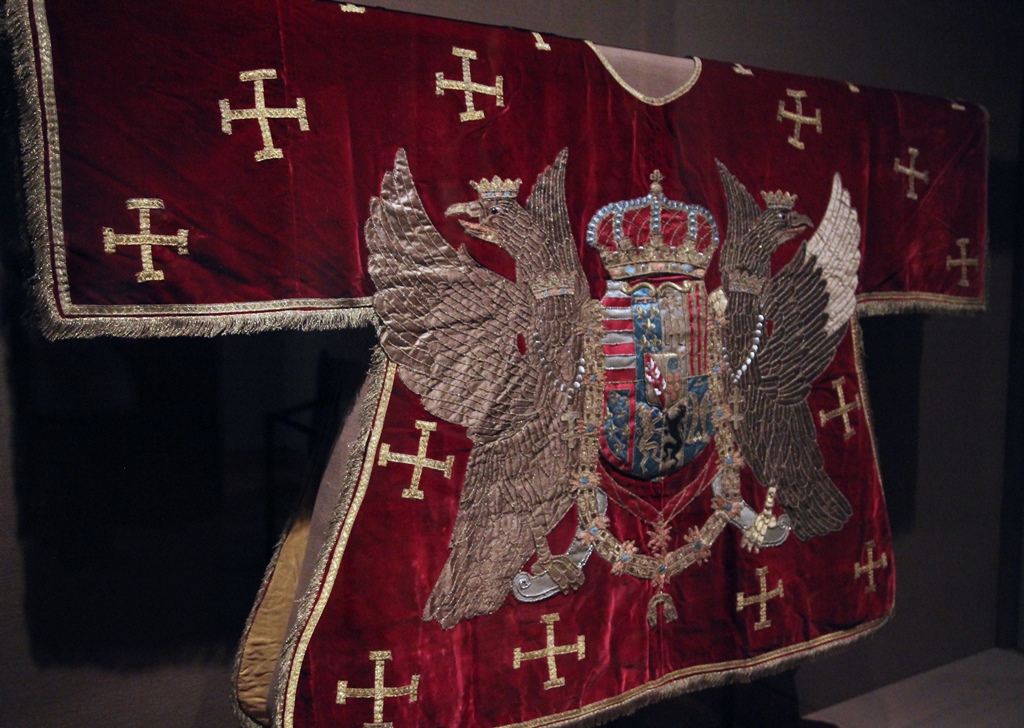
Tabard for the Herald of Emperor Franz Stephan I (1725-50)
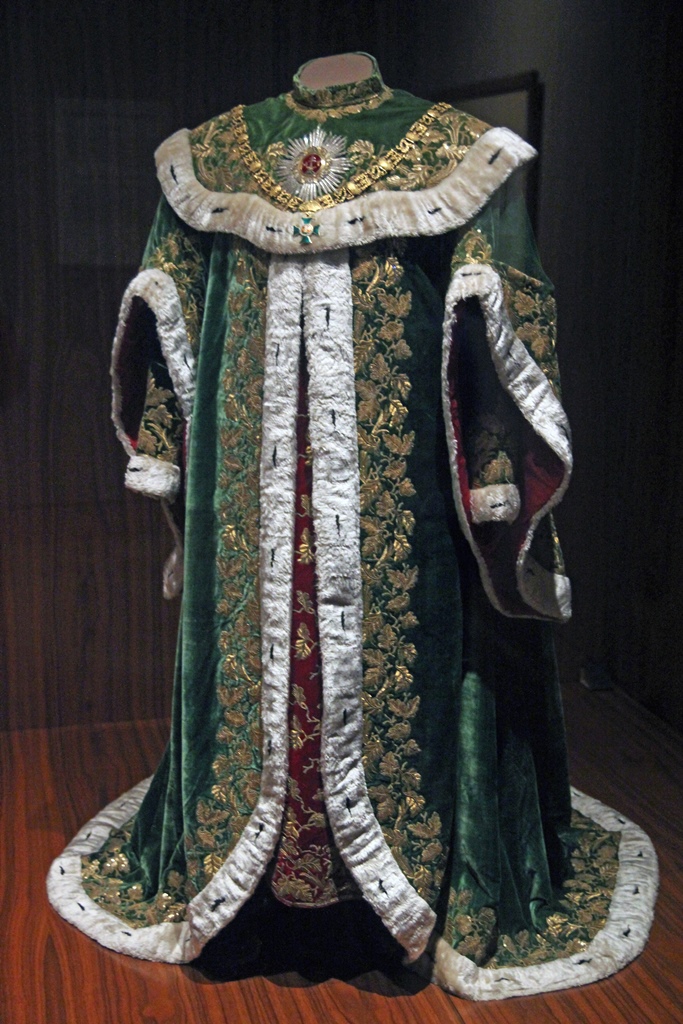
Robes of a Knight of the Hungarian Order of St. Stephen (ca. 1764)
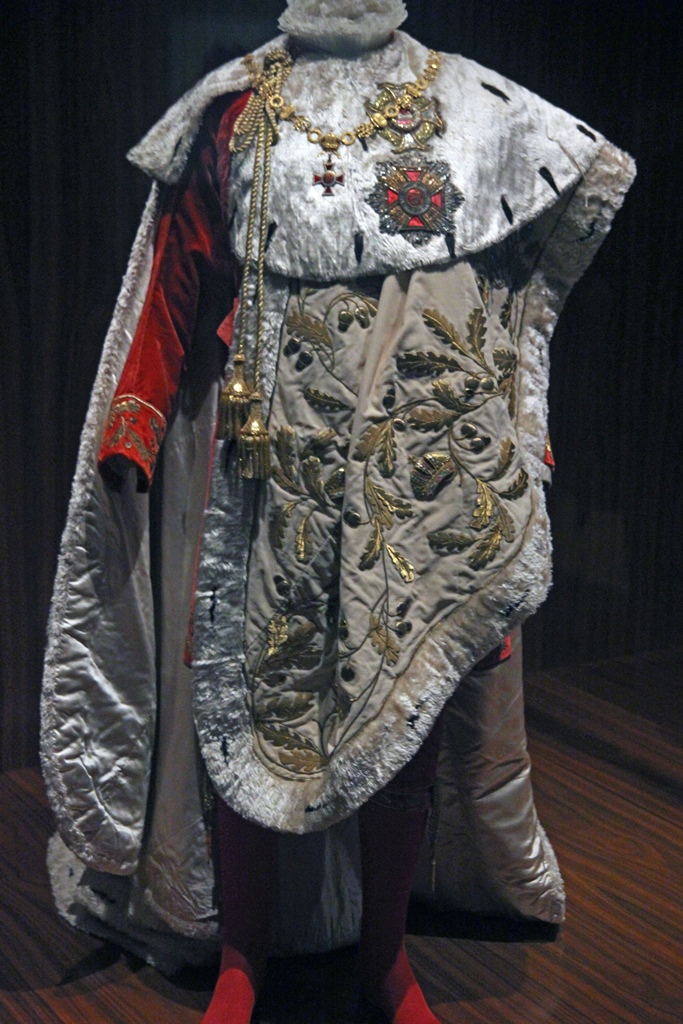
Robes of a Knight of the Austrian Order of Leopold (1808)
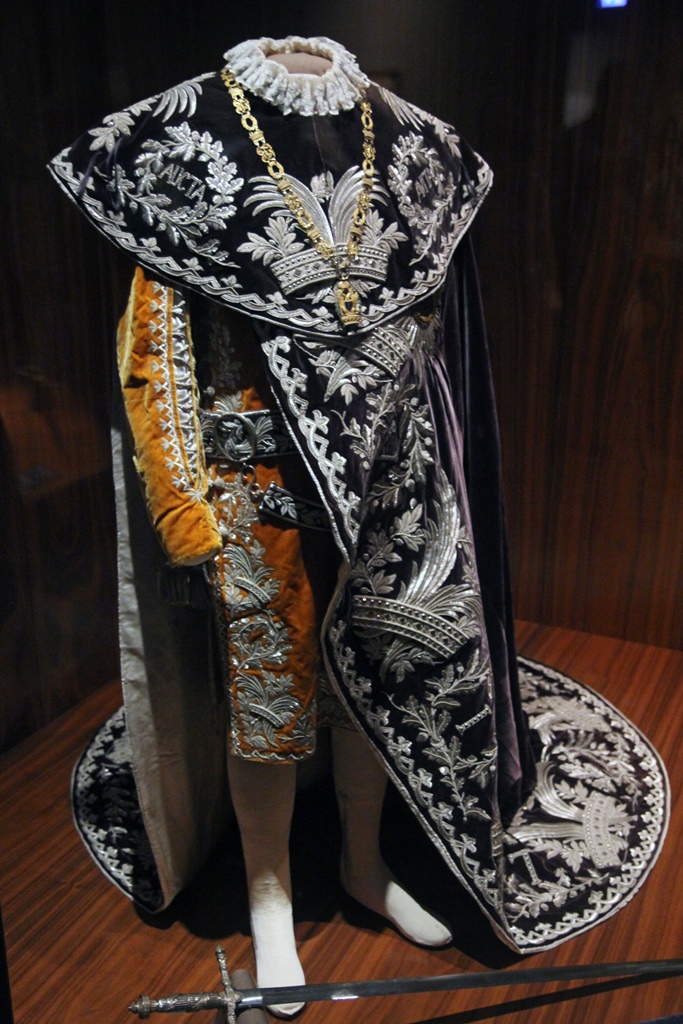
Robes of a Knight of the Austrian Order of the Iron Crown (1815-16)
Next, there is a room with items related to Napoleon Bonaparte, located in Vienna
because of their connection with Marie Louise, daughter of Emperor Francis II
and second wife of Napoleon. The highlight is an elaborate cradle known as the
Cradle of the King of Rome. This cradle is loaded with precious metals, and was
a gift from the city of Paris to the happy couple on the birth of their son,
Napoleon II (who was to die of tuberculosis at the age of 21, without an heir).
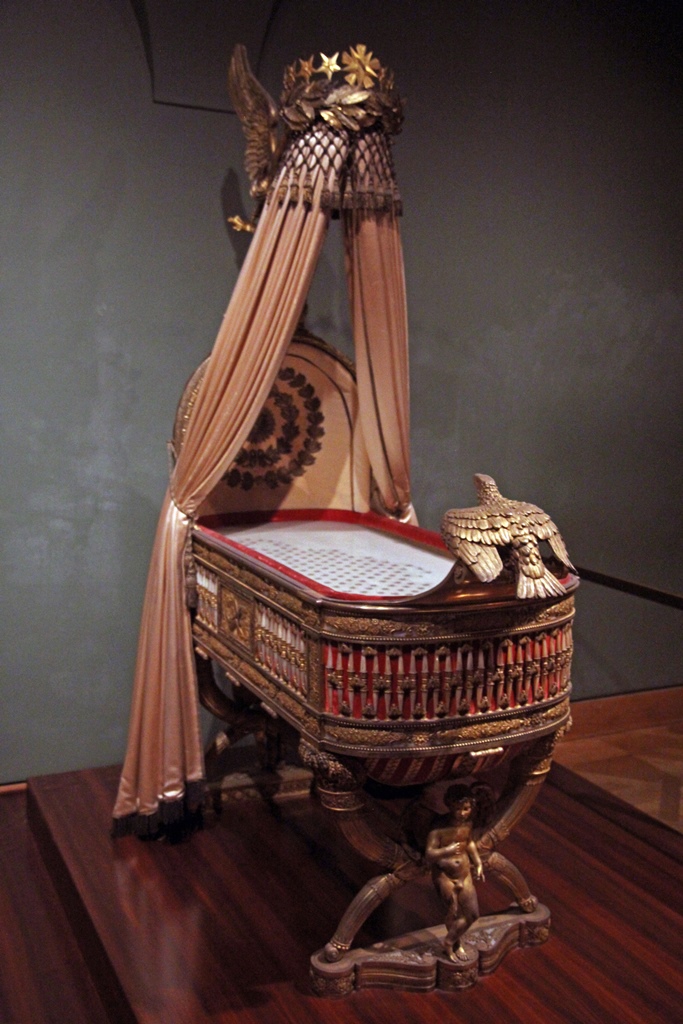
Cradle of the King of Rome (1811)
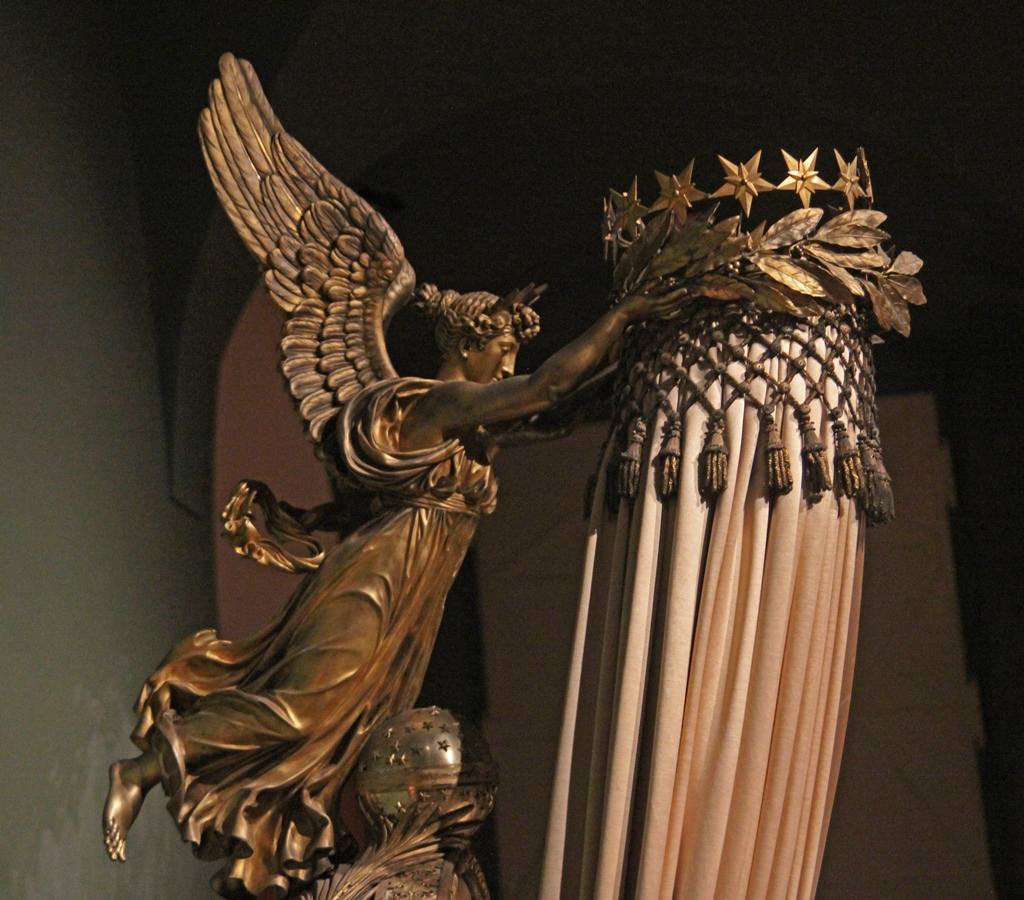
Cradle of the King of Rome (detail)
Napoleon I Bonaparte as King of Italy, Andrea Appiani (ca. 1805)
The next rooms hold some articles that would have to be considered on the ostentatious side.
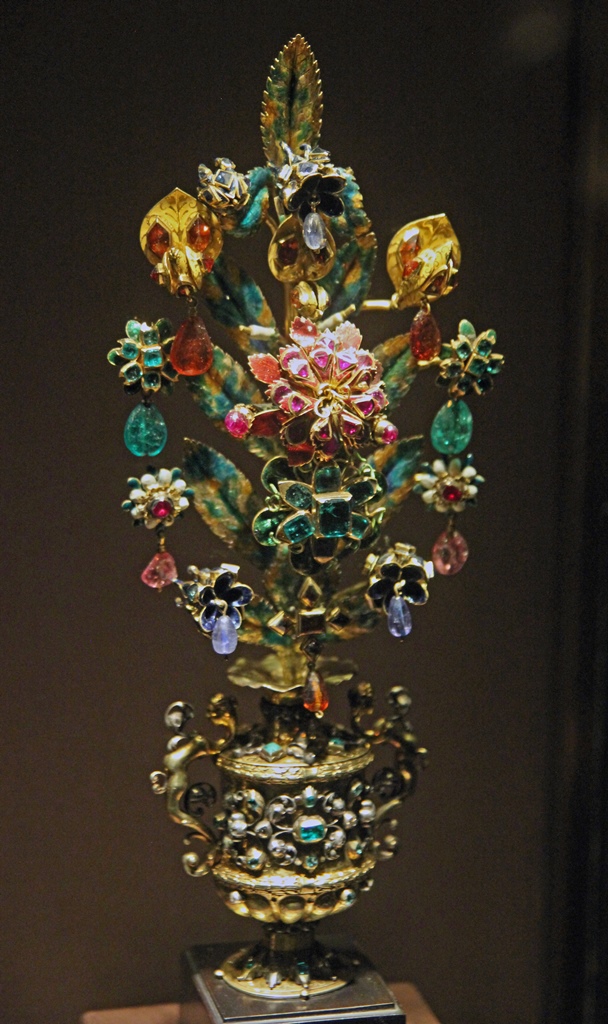
Jewelled Bouquet (1680-1700)
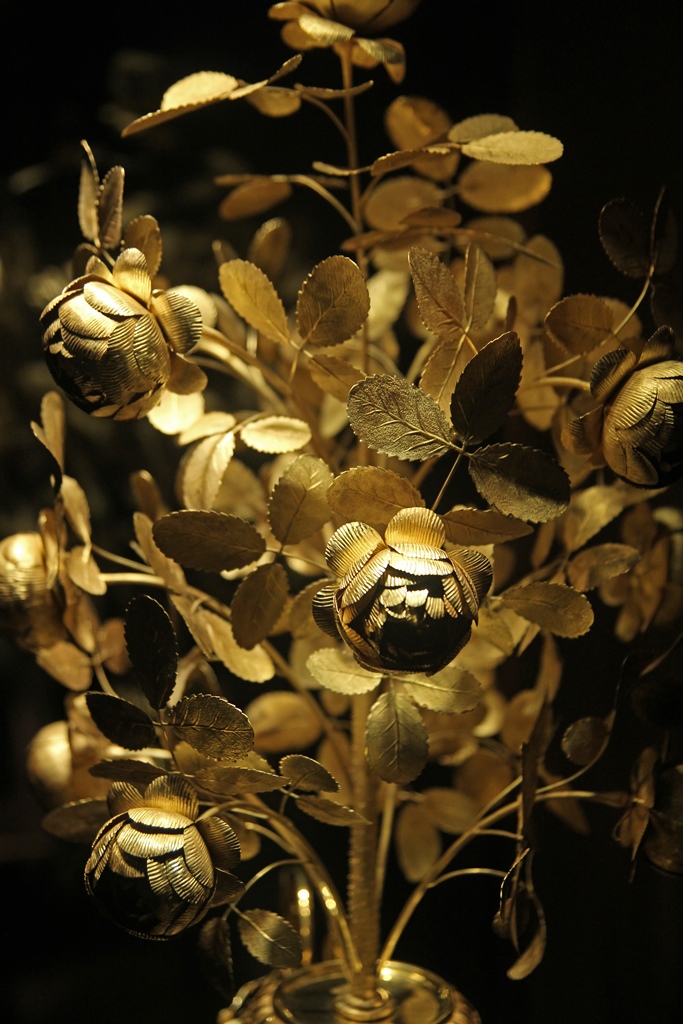
Golden Rose (1818-19)
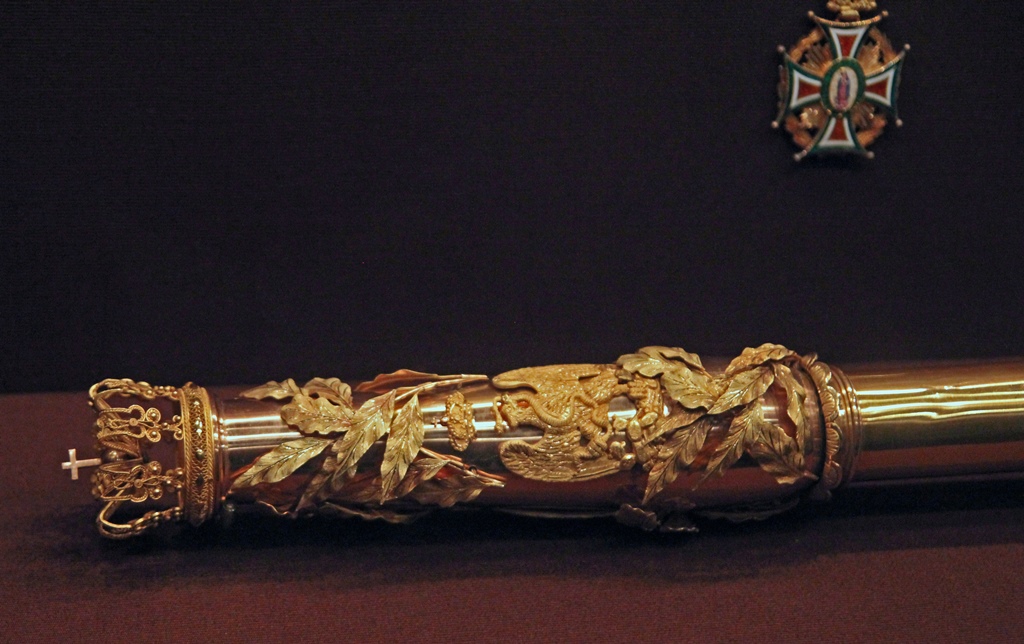
Scepter (1863)
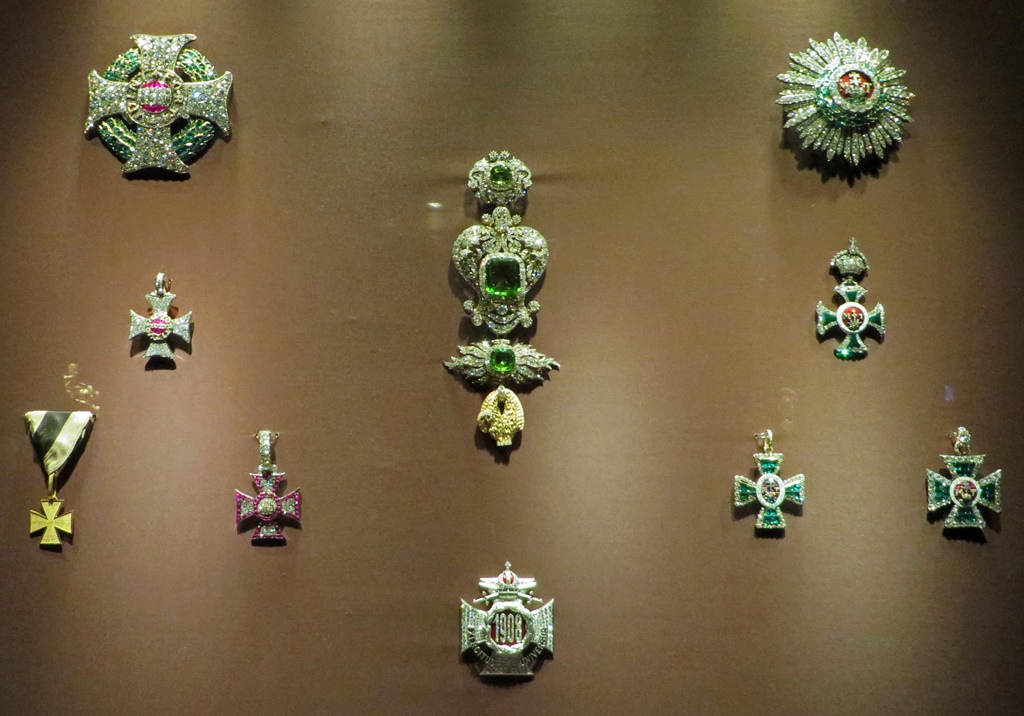
Jewelled Order Medallions
There were also a couple of religious articles in these rooms, containers to be
used cradleside and graveside. The unction vessel is made from the world's
largest cut emerald, at 2860 carats.
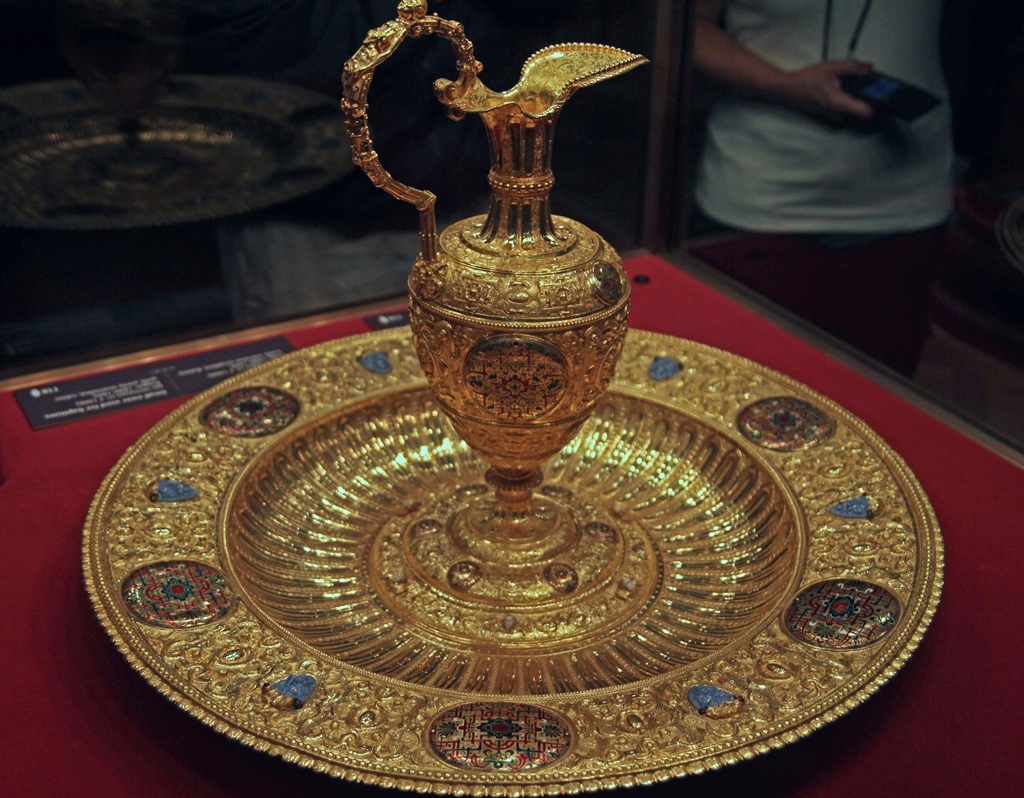
Ewer and Basin Used for Imperial Baptisms (1571)
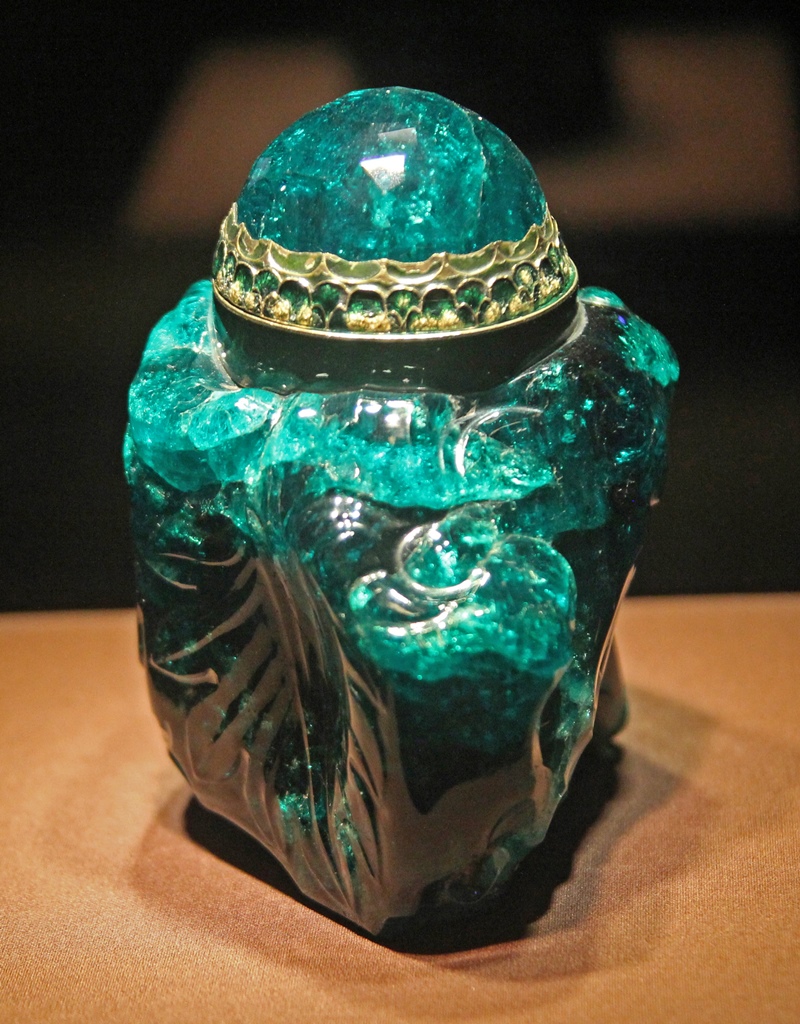
Emerald Unction Vessel (1641)
Another crown found in the Treasury is the Crown of Stefan Bocskay. Bocskay
was elected prince of Transylvania and Hungary in the early 17th Century after
a series of military undertakings, some of which were helpful to the Ottoman
Turks. In 1605 the Ottoman Sultan Ahmed I had this crown made for Bocskay in
appreciation. It's covered with gold, rubies, spinels, emeralds, turquoises
and pearls and came with a carrying case, which is also on display. It
eventually ended up in the Habsburg collection.
Crown of Stefan Bocskay (ca. 1605)
Entering into the more overtly religious part of the collection (called the
Ecclesiastical Collection), we ran into an impressive golden structure that
turned out to be a reproduction of an actual monument that exists in a Vienna
square called Am Hof (historical in its own right – the end of the
Holy Roman Empire was declared in this square in 1806). The monument was
built between 1664 and 1667 by Ferdinand III to thank the Virgin Mary for her
help in repelling Swedish forces during the Thirty Years' War. The golden
reproduction was created between 1675 and 1678.
Column of the Virgin Mary, Am Hof
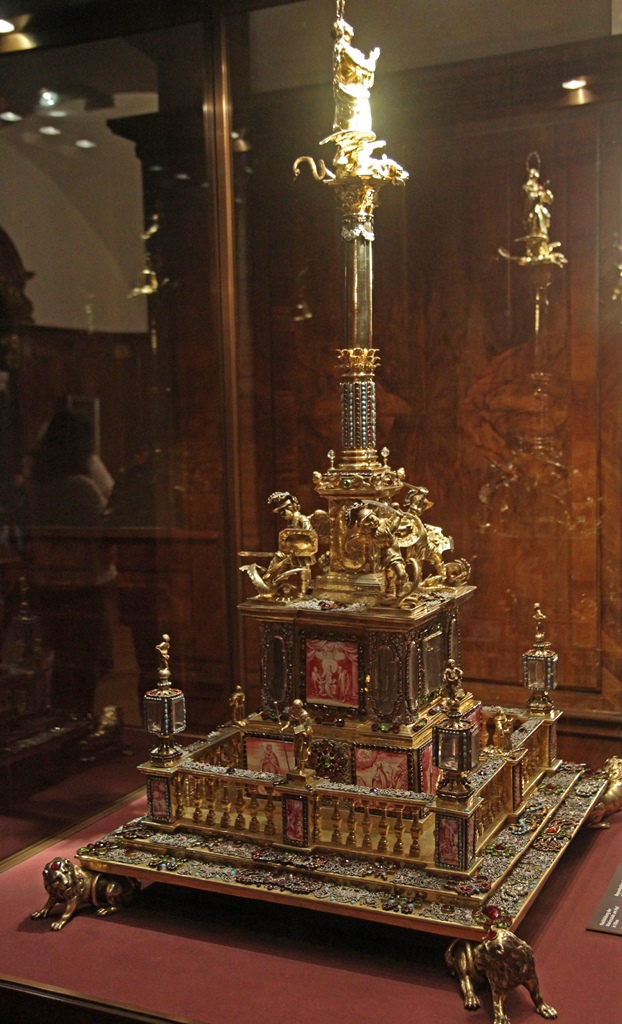
Column of the Virgin Mary (reproduction, ca. 1675-78)
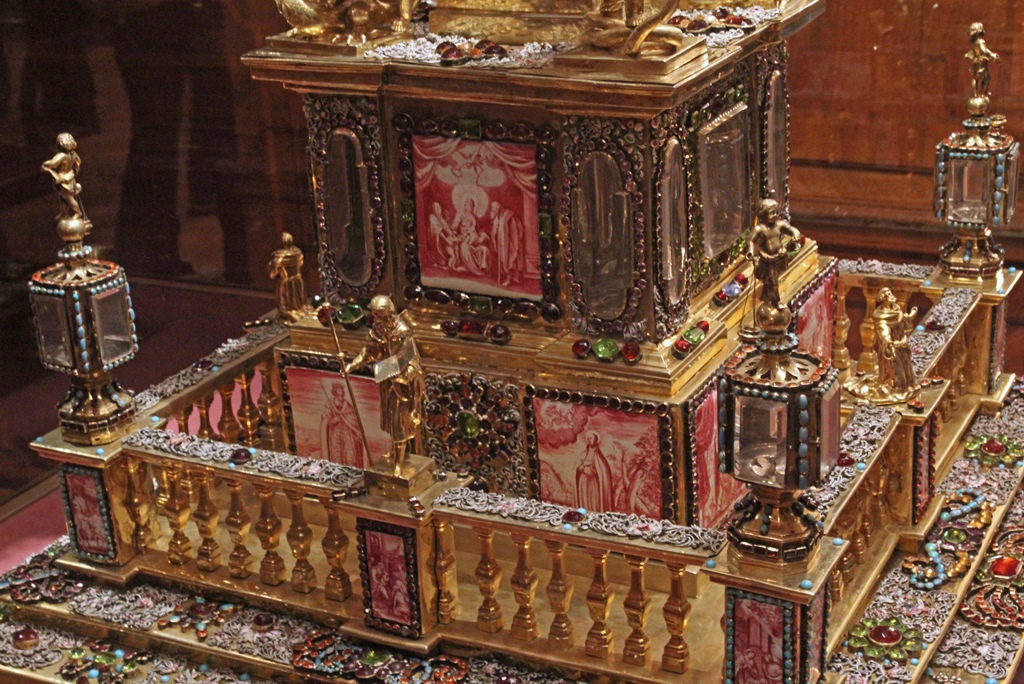
Column of the Virgin Mary (base)
The Ecclesiastical Collection presented a large number of articles, both large and
small, many containing relics of one type or another.
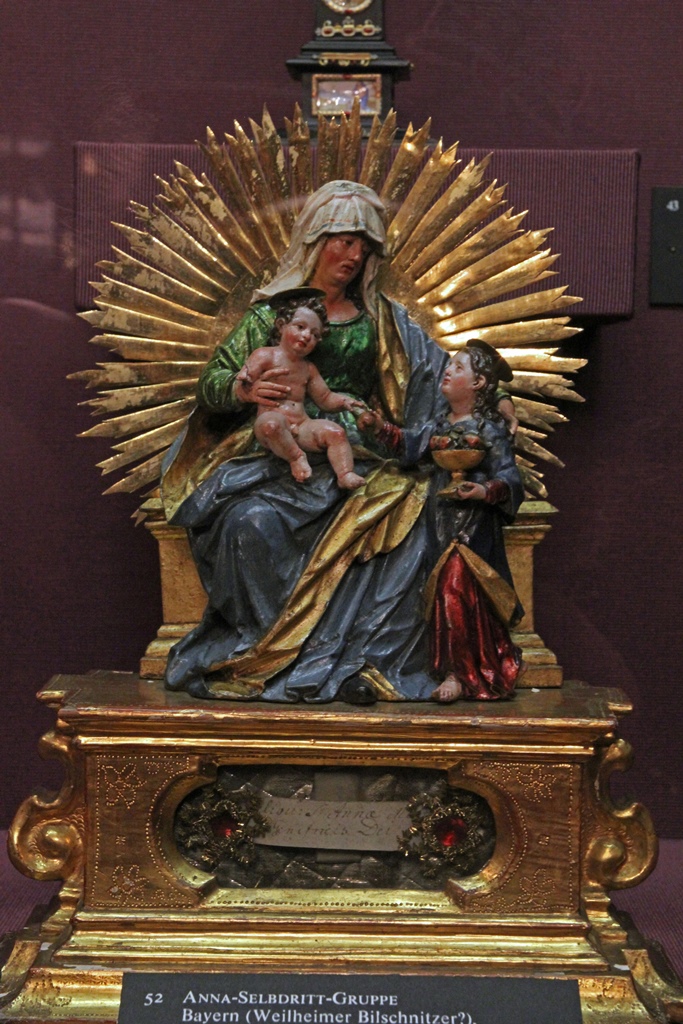
Group Reliquary (ca. 1620)
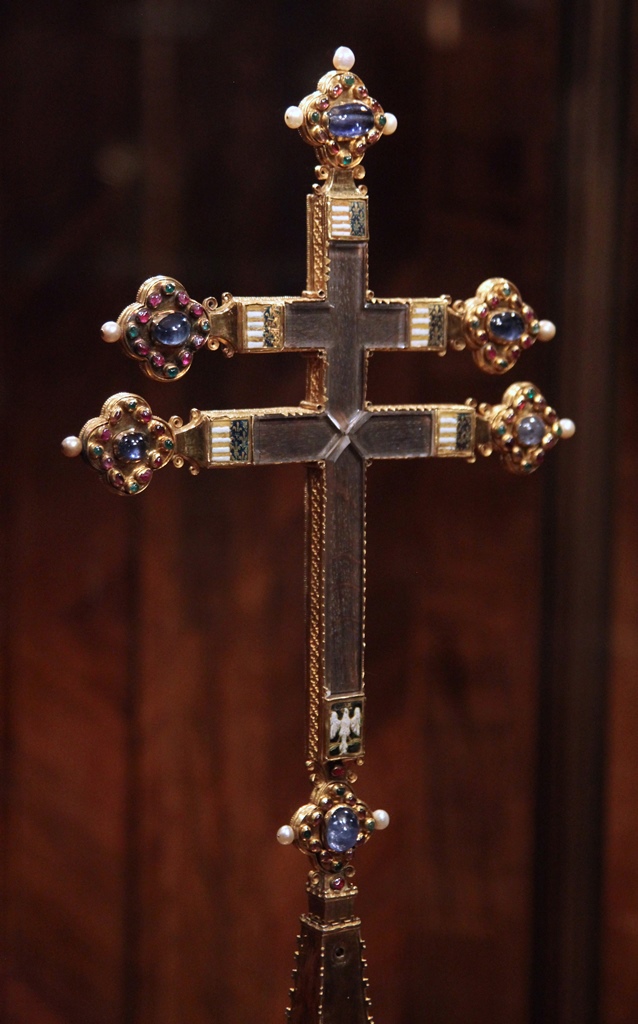
Reliquary Cross of King Ludwig the Great of Hungary (1370-82)
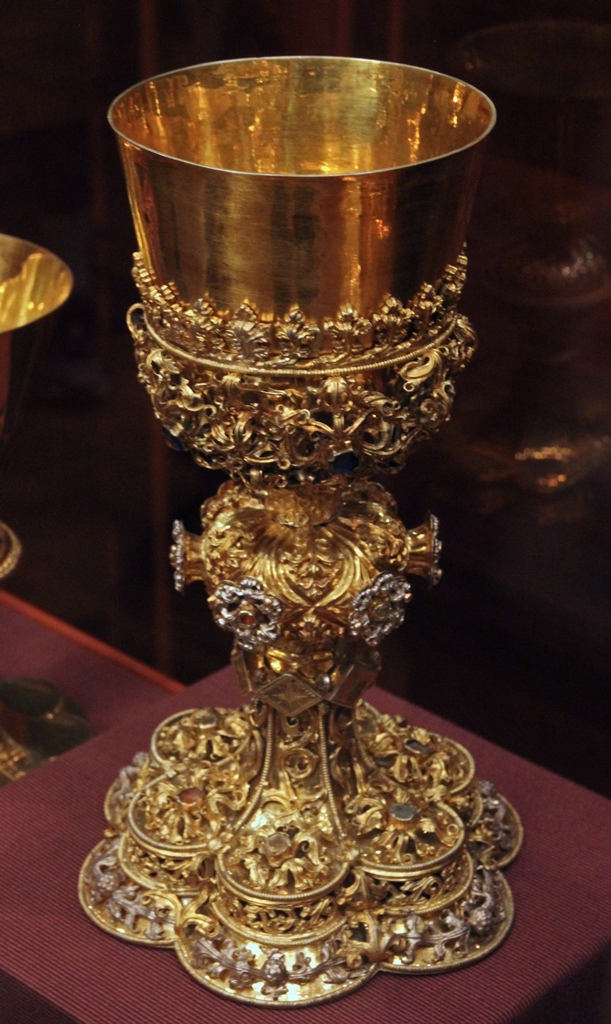
Late Gothic Chalice (ca. 1500)
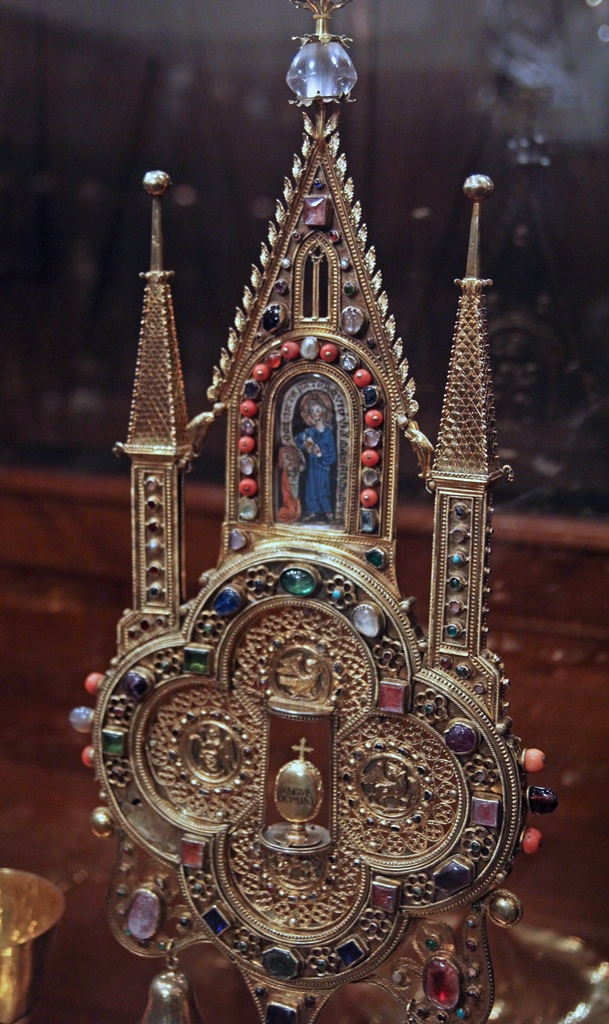
Holy Blood Monstrance (15th C.)
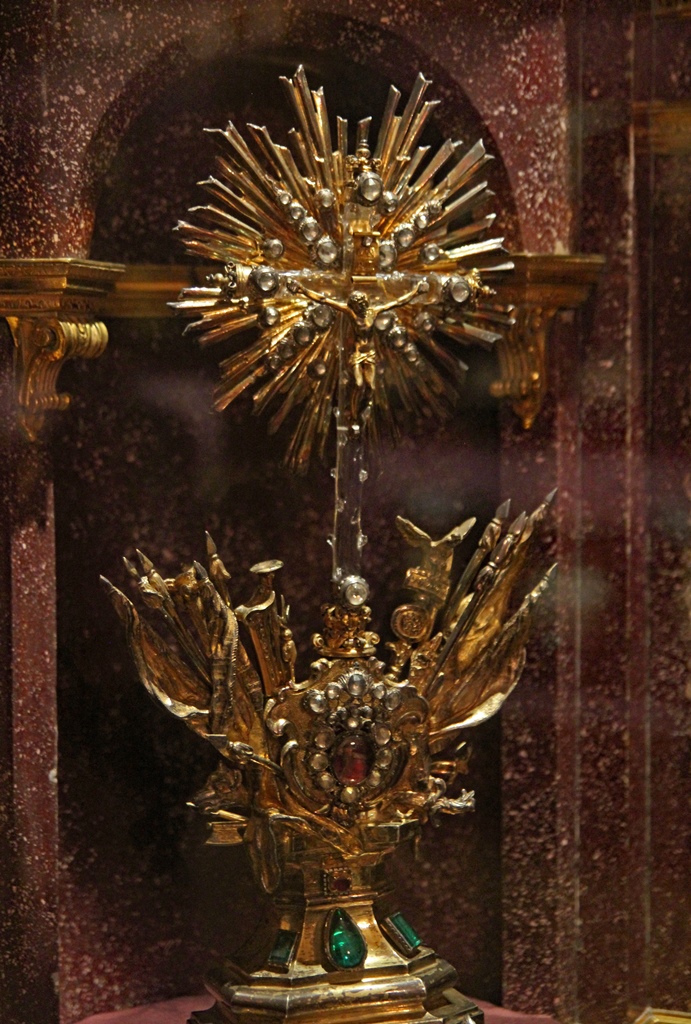
Tabernacle with Ostensorium for a Particle of the Cross (1711)
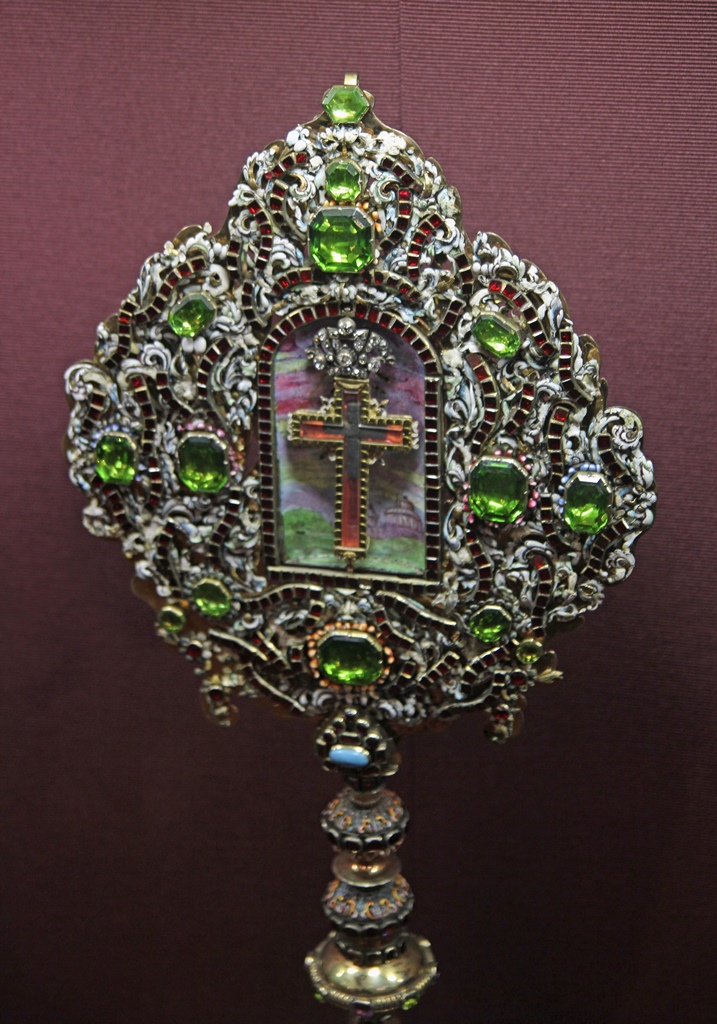
Monstrance for Particle of Cross (ca. 1668)
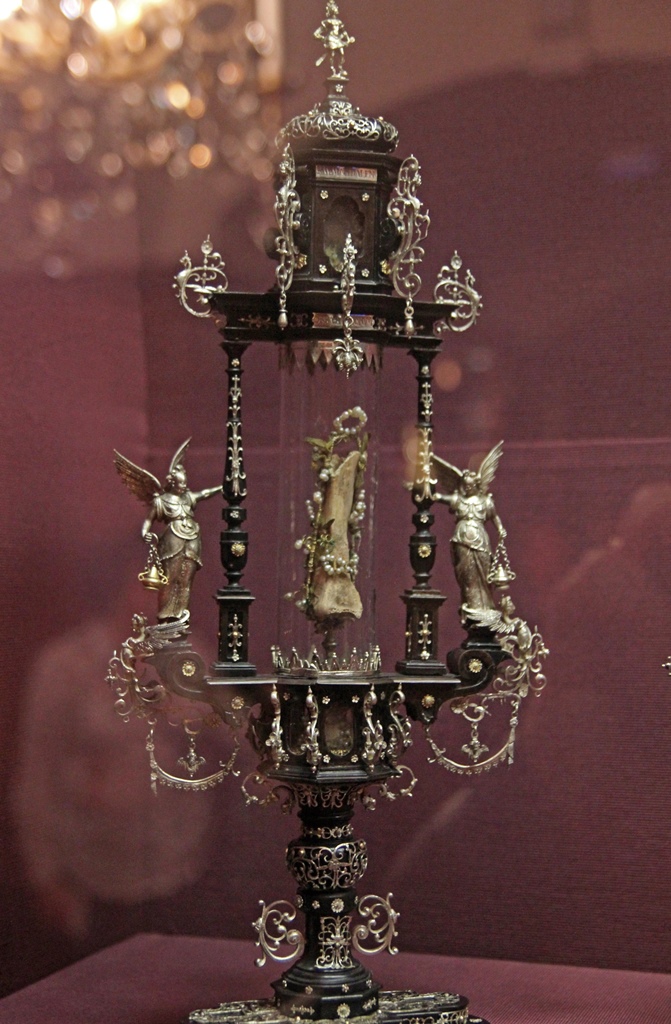
Reliquary, Matthew Walbaum (17th C.)
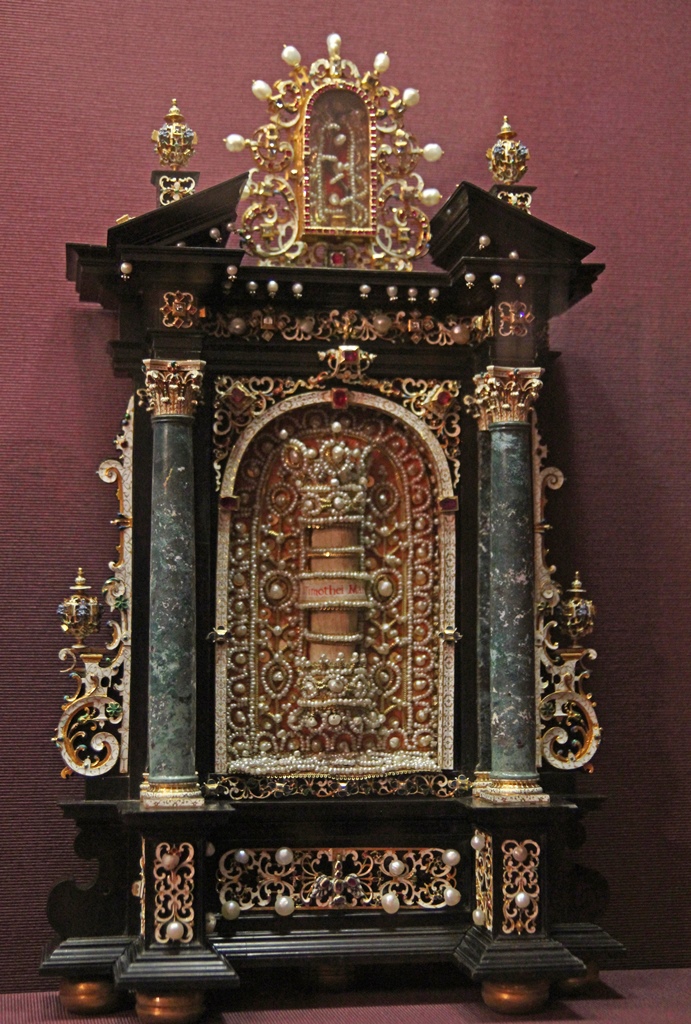
Reliquary (1618-22)
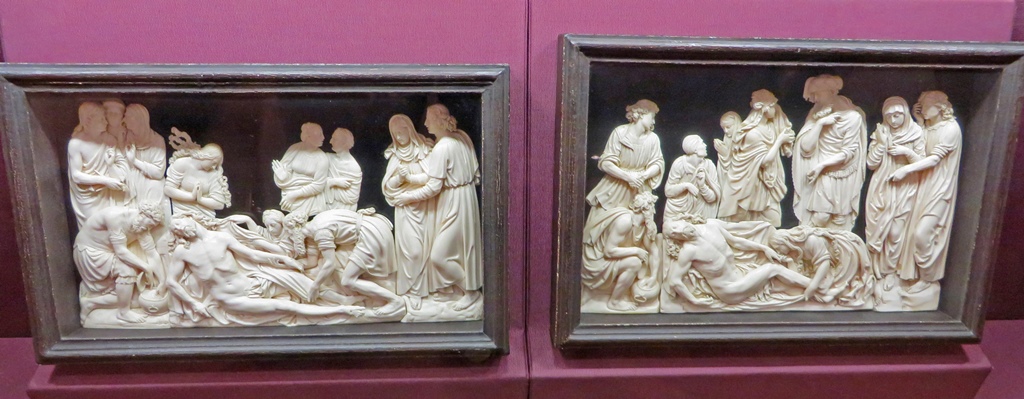
Ivory Reliefs of Lamentation of Christ (1614-20)
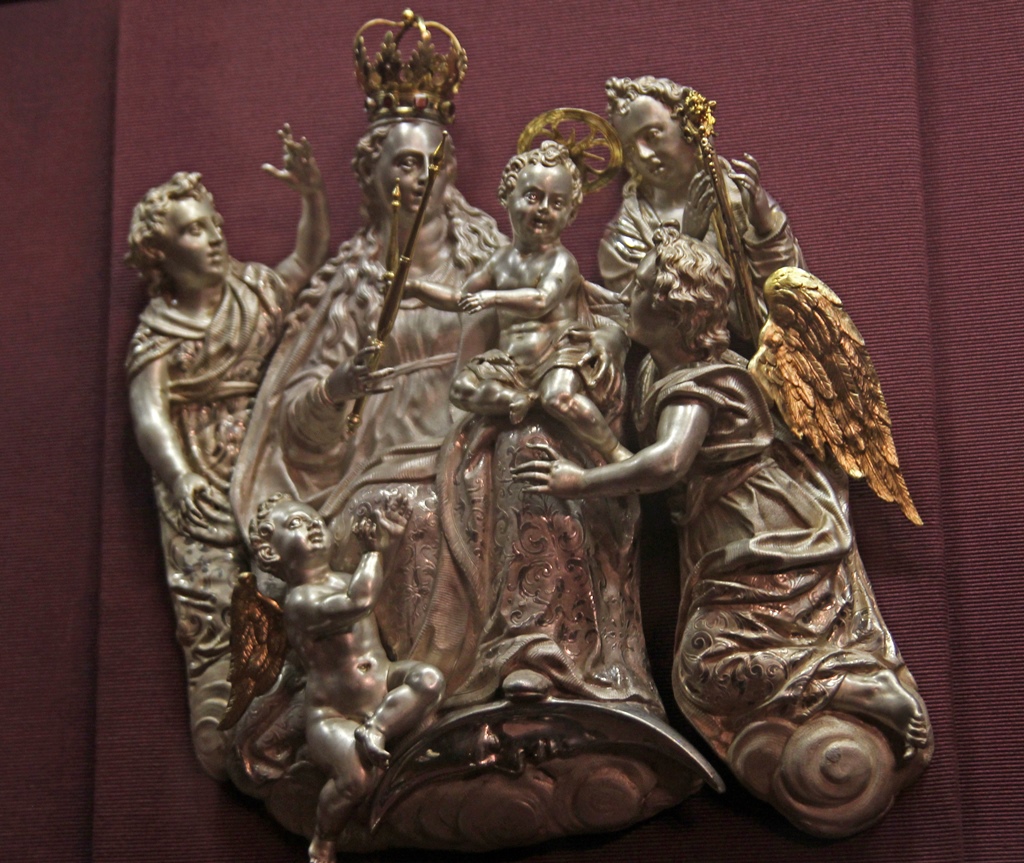
Silver Altar Relief (ca. 1600)
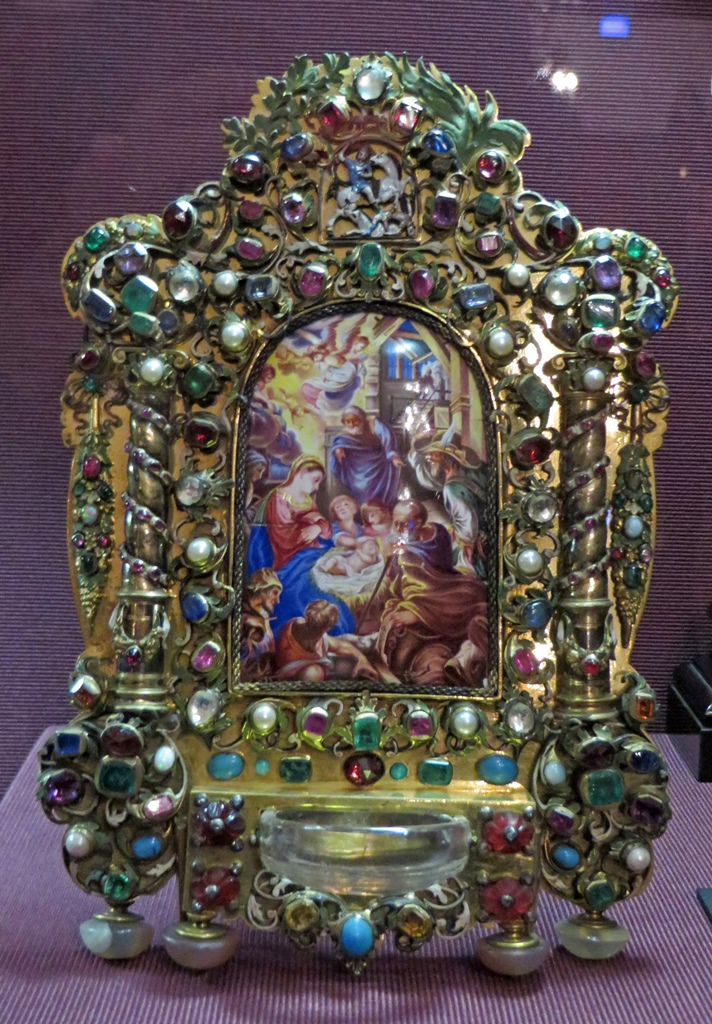
Holy Water Vessel (17th C.)
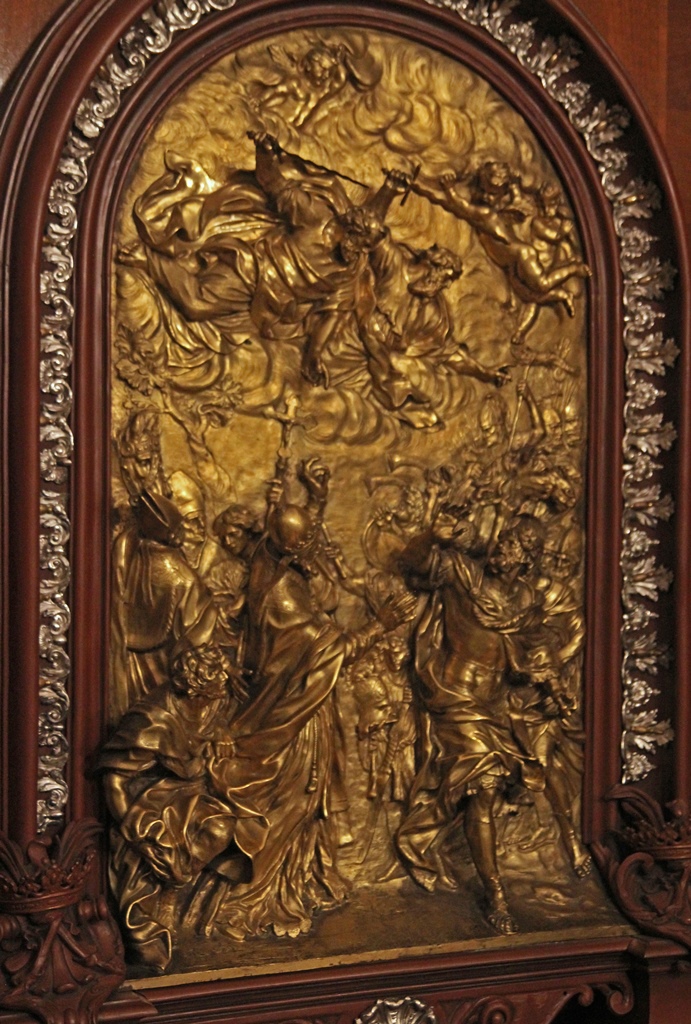
Gilded Relief of Pope Leo the Great Meeting Attila the Hun (after 1657)
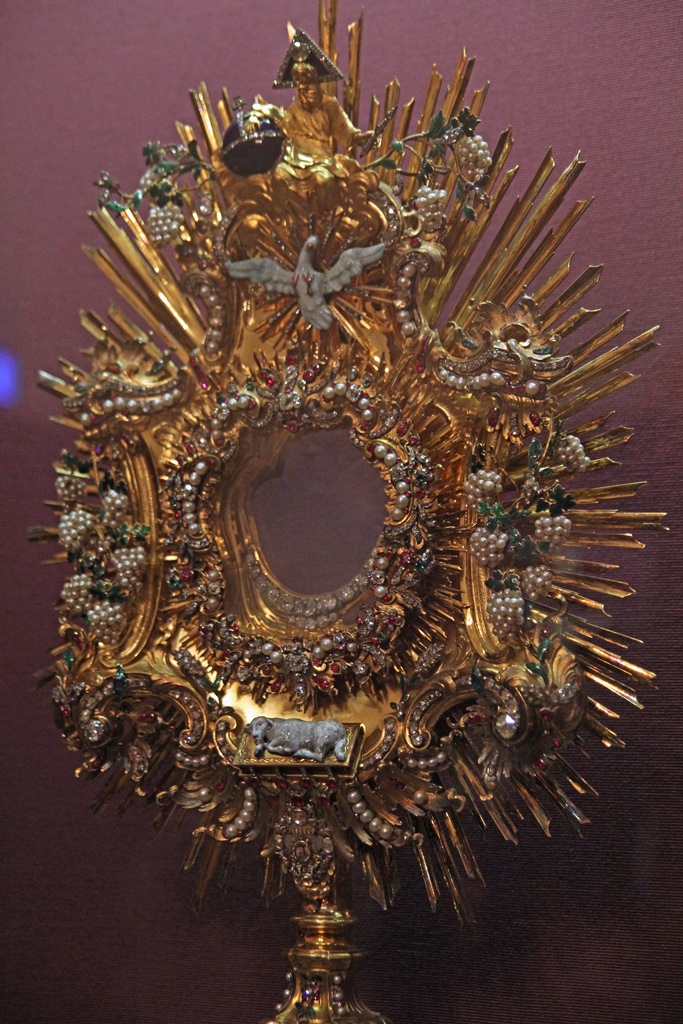
Monstrance (1760)
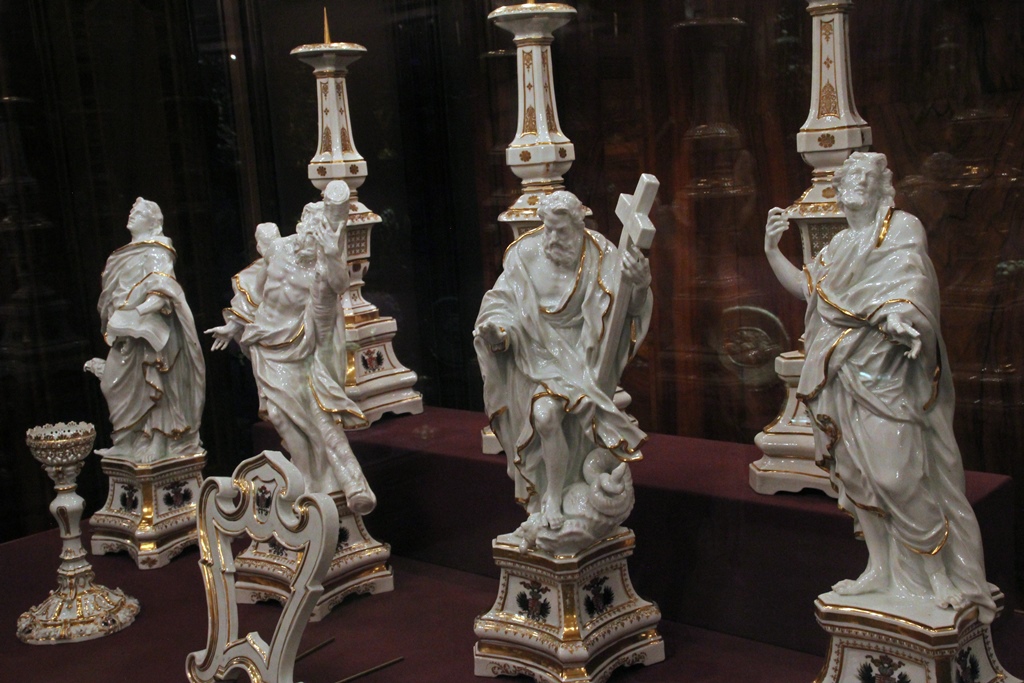
Figures, Altarpiece of Empress Wilhelmina Amalia (ca. 1737-41)
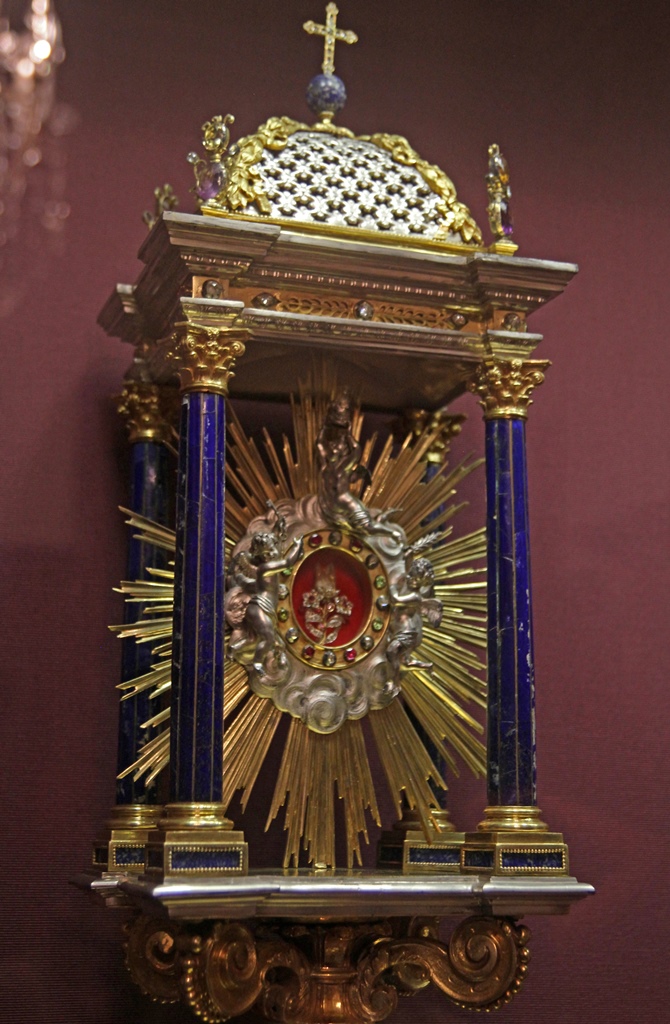
Reliquary with a Tooth of St. Peter (19th C.)
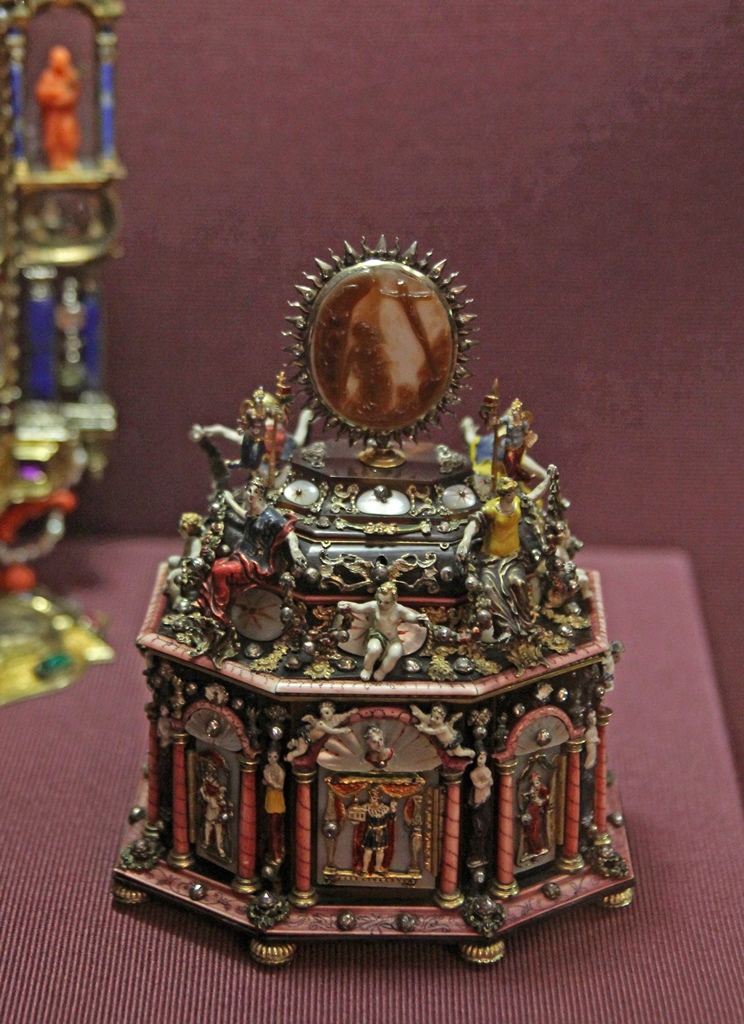
Tortoiseshell Case (ca. 1700)
One of the most spectacular items in the collection is a 6-foot-tall altar
made mostly of amber. It was a diplomatic gift to Emperor Leopold I from Elector
Frederick III of Prussia. The altar dates from about 1645 and was presented in
1701.
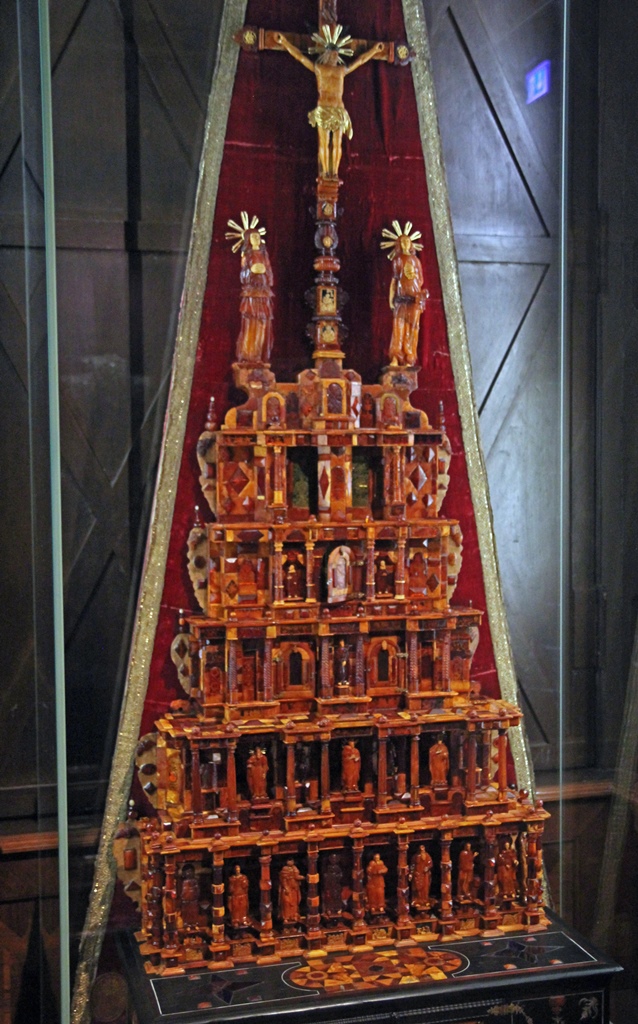
Amber Altar (ca. 1640-45)
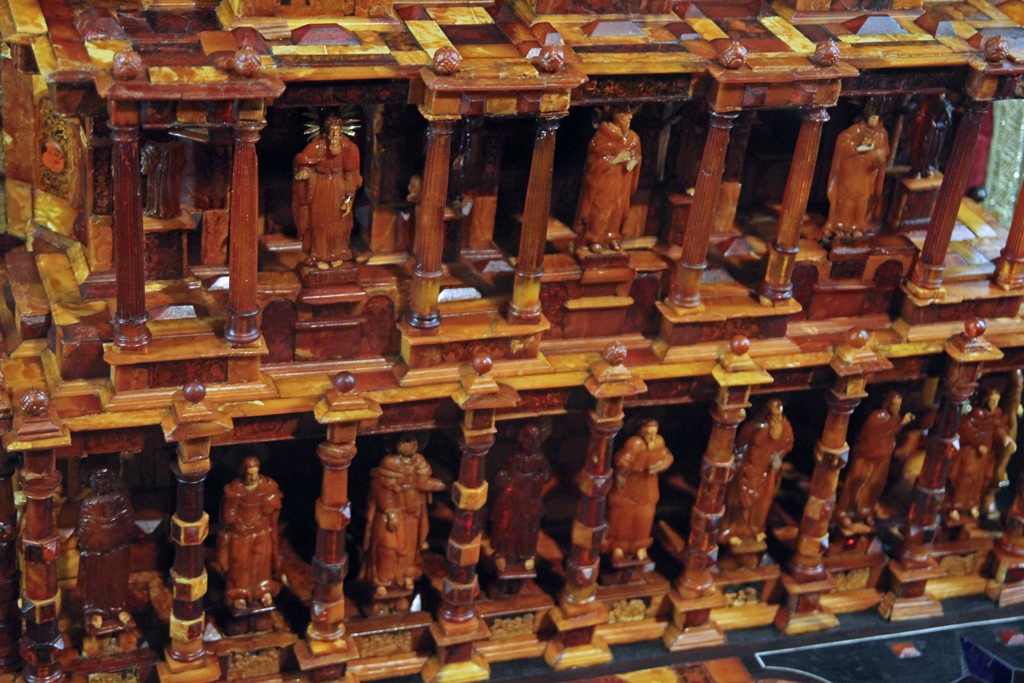
Amber Altar (detail)
Then we came upon the Imperial Crown of the Holy Roman Empire, no longer worn
for obvious reasons (but kept around, just in case). It was probably made in
Germany, apparently around the year 1000, give or take a few decades. From
1349-1421 it was kept in the purpose-built Carlstein Castle in Bohemia (now in
the Czech Republic), and after that (until 1796) in Nuremberg, which (as
mentioned above) it could only leave when there was a coronation to be done.
The crown (and Imperial Regalia) was moved from Nuremberg to Vienna around 1800,
to protect it from Napoleon's marauding forces. In 1938, the Nazis moved it
back to Nuremberg, but after World War II ended, it was returned to Vienna by
U.S. forces.
The crown is made of eight gold plates (around 22 carat), making it octagonal in
shape, with a cross on top of the front plate and an arch connecting the front
plate with the back plate. The crown is covered with precious stones (144 of
them – sapphires, emeralds and amethysts) and a like number of pearls. The
stones are not faceted (this technique hadn't been invented yet when the crown
was created), but are rounded and polished. Half of the plates carry enameled
depictions of biblical scenes (three of them Old Testament). There are Latin
inscriptions along both sides of the arch, spelled out in tiny pearls.
Translated, they say "Conrad, by the Grace of God" (a reference to Emperor
Conrad II) and "Emperor of the Romans and Augustus".
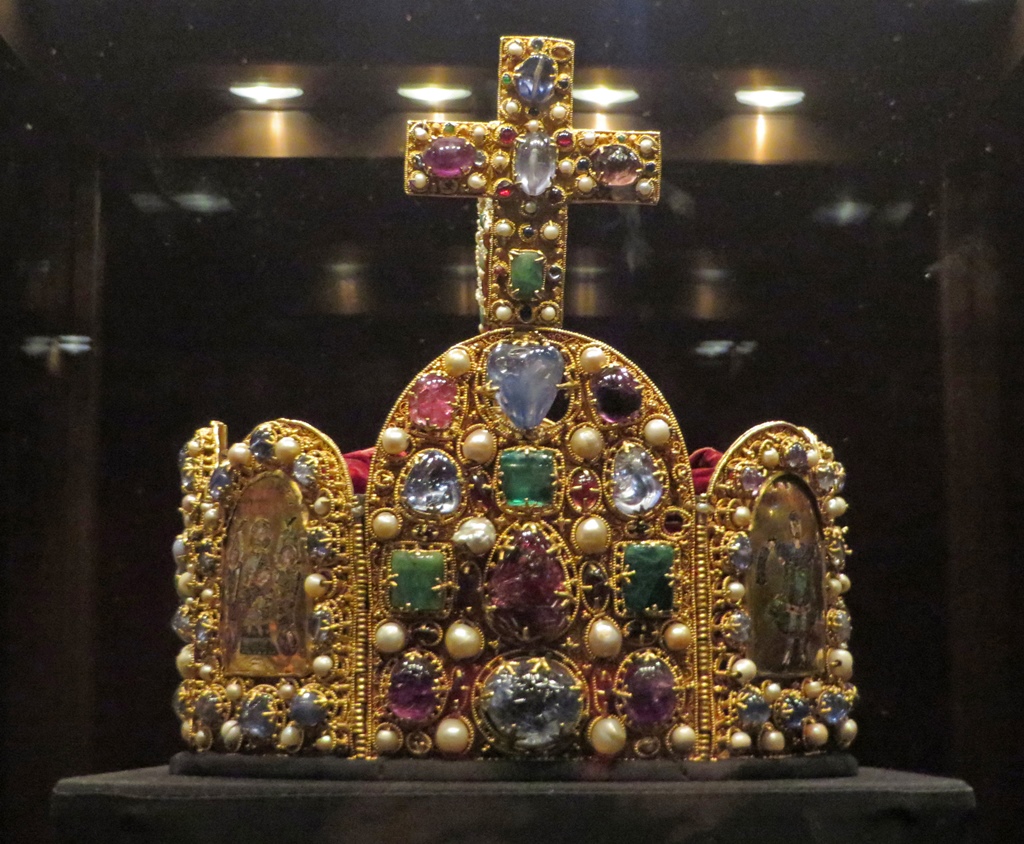
Imperial Crown of the Holy Roman Empire (960-1039)
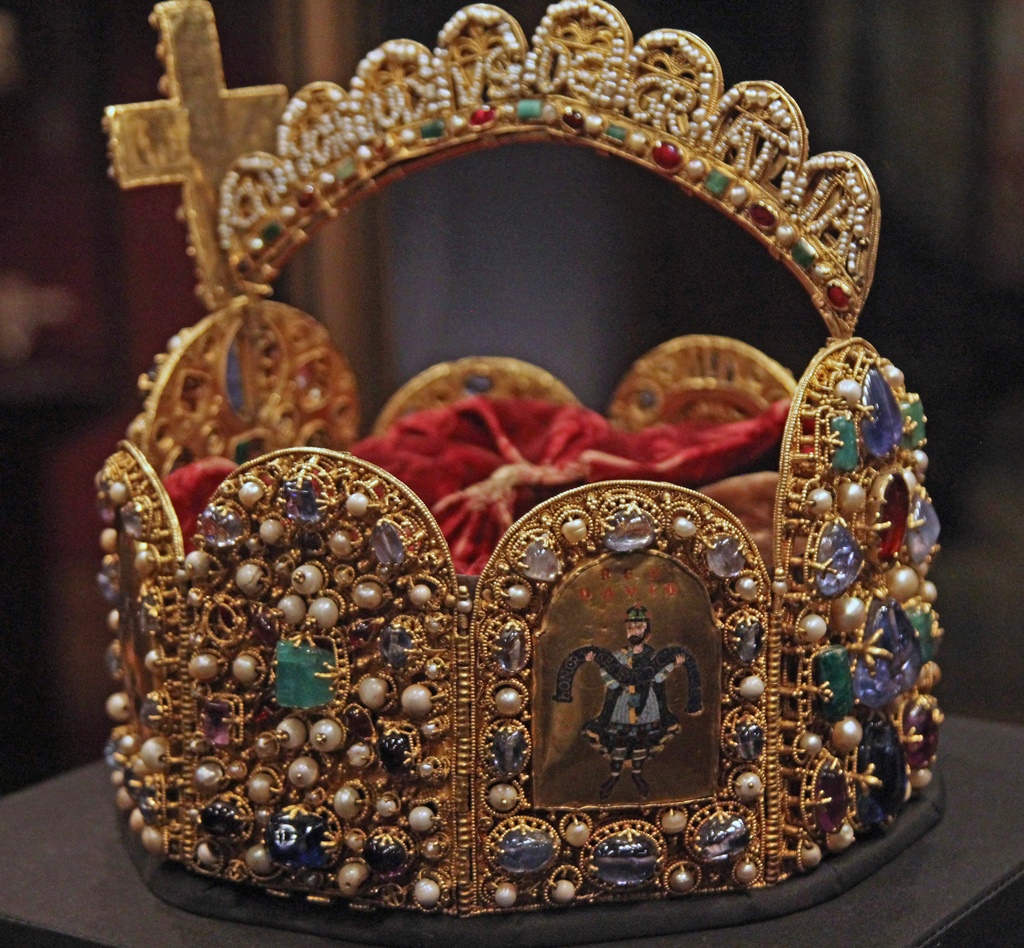
Imperial Crown
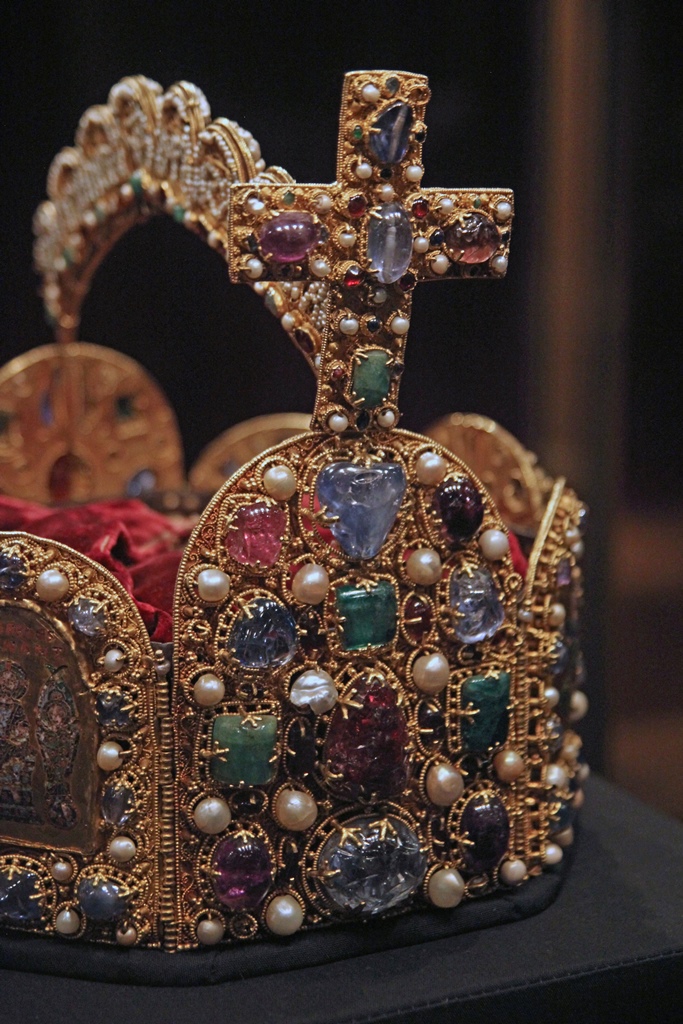
Imperial Crown
Displayed near the crown is the stylistically similar Imperial Cross, probably
made around the same time. The Imperial Cross is essentially an overproduced
reliquary, designed to hold two invaluable relics from the Crucifixion of Christ,
the Holy Lance and a Particle of the True Cross, which are displayed next to the
cross. The Holy Lance is the spear that was used to pierce the side of Jesus as
he hung on the cross. But this lance (just the spearhead, to be precise) is
apparently not the correct one, as the metal has been dated back to the 8th
Century A.D. at the earliest. The situation with the cross fragment is less
clear, but if it was bought by the same people who bought the lance, one would
have to worry. The small, cross-shaped reliquary containing the fragment (which
apparently fits into the larger Imperial Cross) dates to sometime after 1350.
The Imperial Cross is wood on the inside, and is covered with gold leaf, pearls
and gemstones.
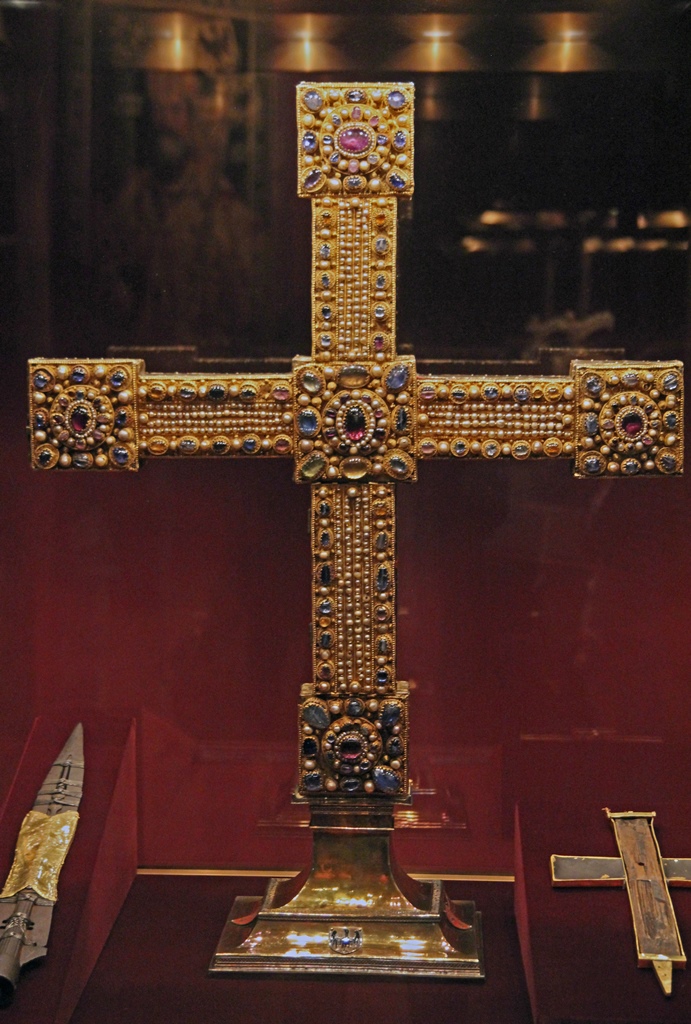
Imperial Cross (ca. 1030)
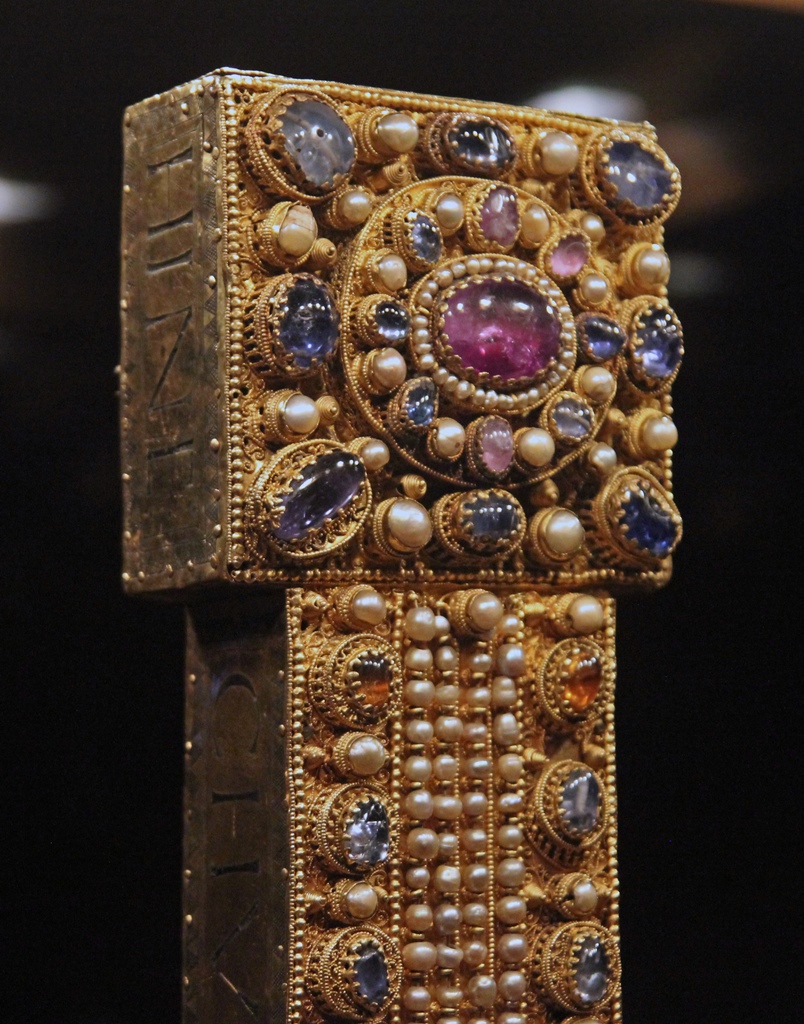
Imperial Cross (detail)
There are a number of exhibits in the Schatzkammer related to the Order of the
Golden Fleece, which was founded in 1430 as a Roman Catholic order of chivalry.
The Order continues to exist to this day, and allows only 50 or so members at
any one time. The members are often heads of state, and being invited to join
is a great honor. There have been two branches, an Austrian branch and a
Spanish branch, since the War of the Spanish Succession, which ended in 1714.
Over the years the membership rules have been relaxed enough to include women
and non-Catholics, but it's still a pretty tough group to get into. The
Sovereign of the Spanish Order is the King of Spain, currently Felipe IV, and
the Sovereign of the Austrian Order is the head of the House of Habsburg,
currently Karl von Habsburg, grandson of the last Austrian Emperor, Charles I.
I'm not sure exactly what Order members actually do as a group, besides
encourage each other to perform noble deeds. There are officers and rules and
special clothes and special jewelry, and no doubt a secret handshake. Maybe
there's charity work involved. Or maybe they get together at the Duke of
Württemberg's place to watch the World Cup on TV while drinking too much and
cursing the referees. Hard to say – it seems pretty mysterious.
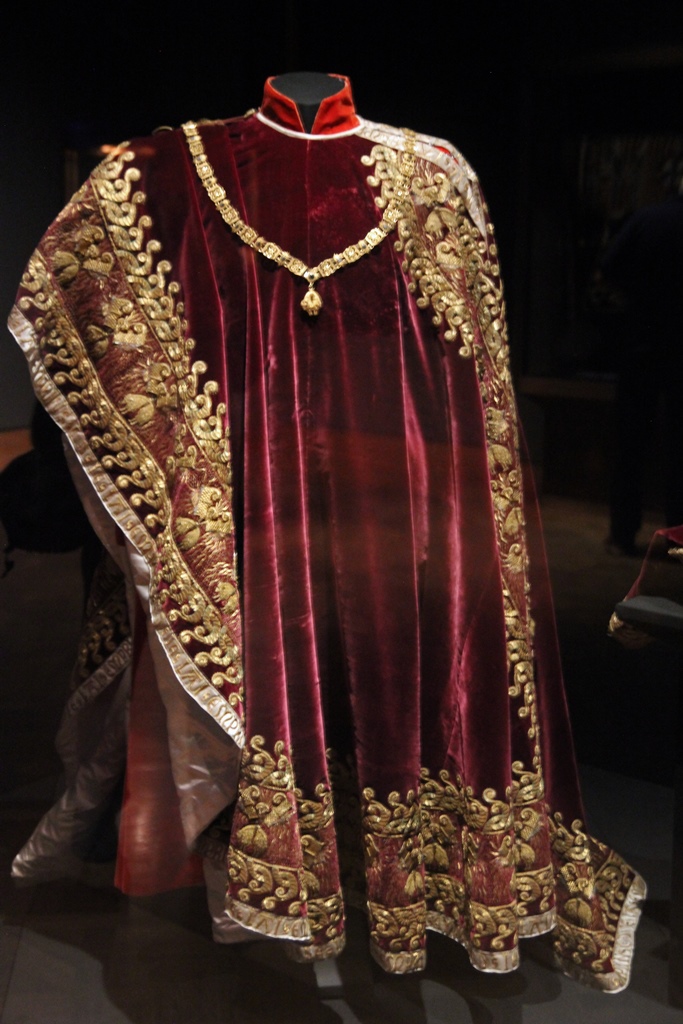
Robes (1712) and Chain (1836) of a Knight of the Order of the Golden Fleece
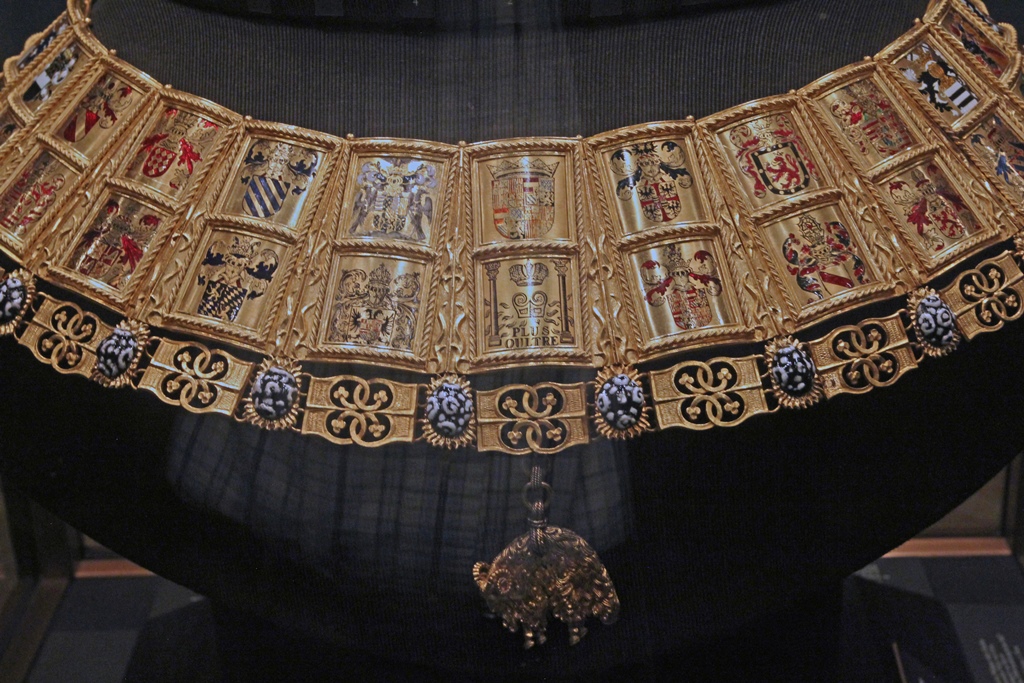
Potence of the Herald of the Order of the Golden Fleece (1517)
Other exhibits feature articles (clothes and such) used by court attendees.
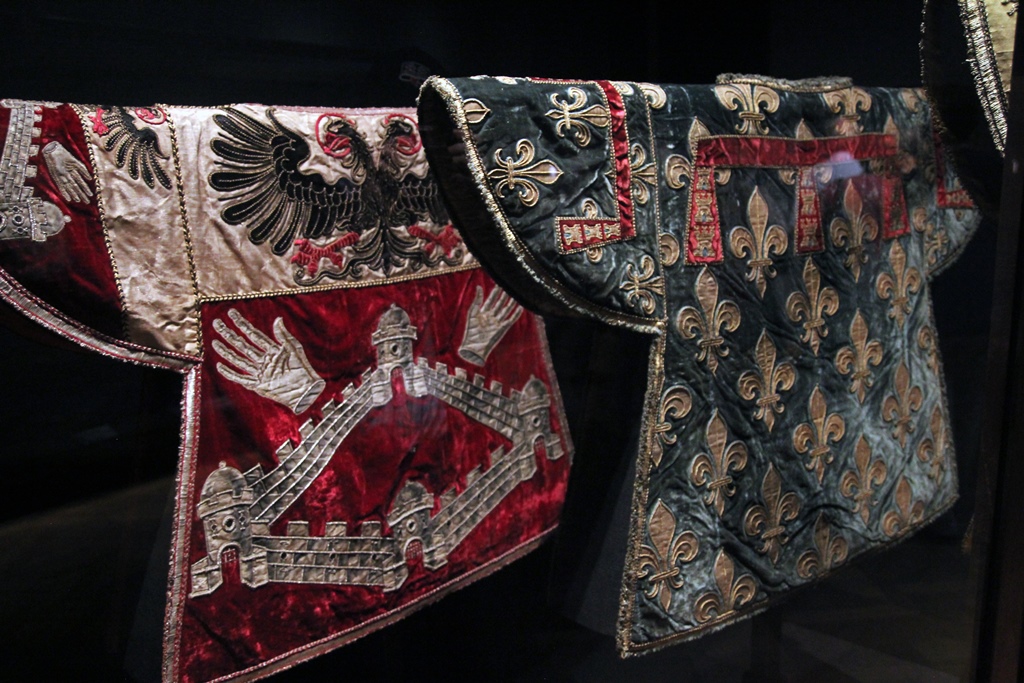
Herald's Tabards for the Magraviate of Antwerp and County of Artois (17th C.)
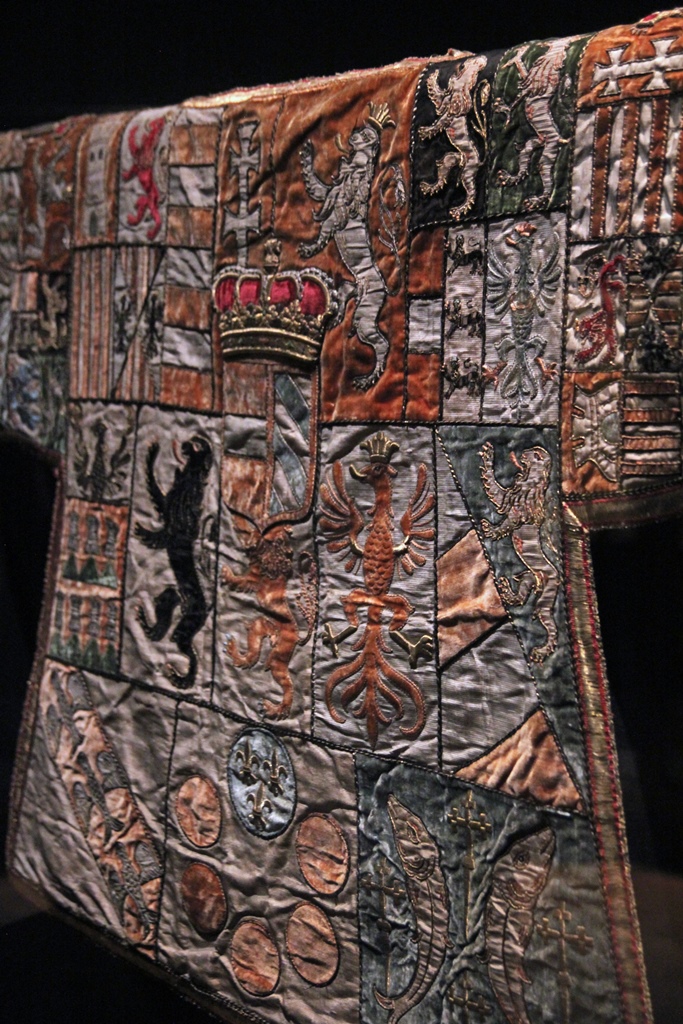
Tabard for a Herald of Maria Theresa (1742)
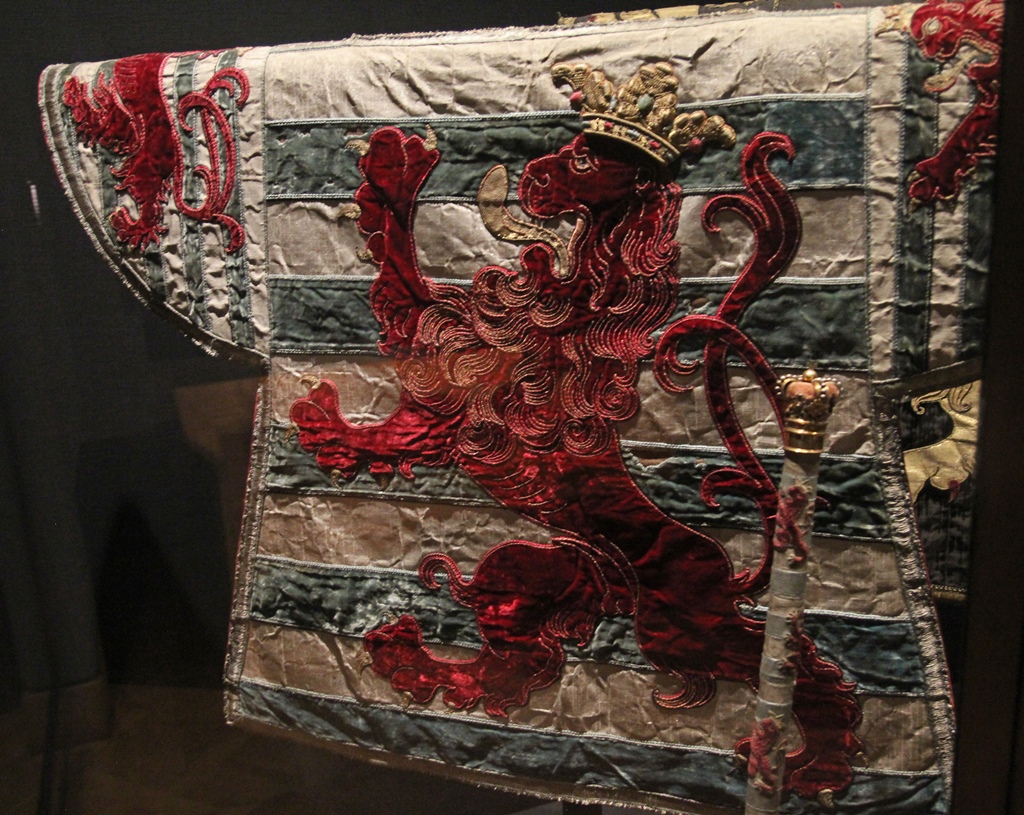
Tabard for the King-At-Arms and Herald of the Duchy of Luxemburg (17th C.)
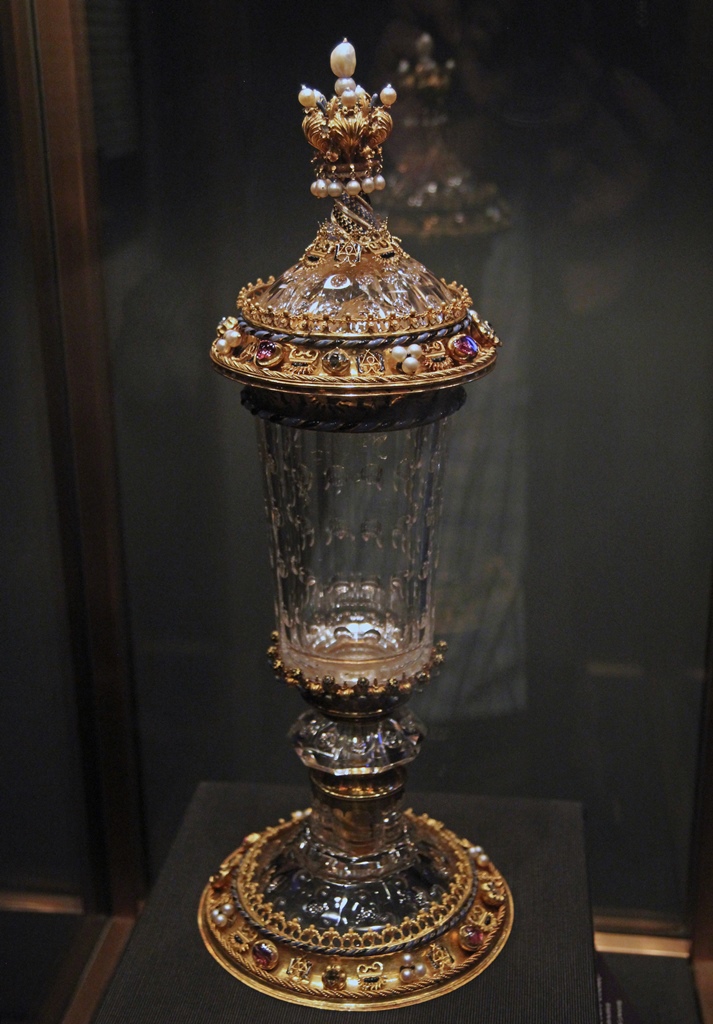
Burgundian Court Goblet (ca. 1453-67)
The Schatzkammer exhibits end with a selection of finely woven Burgundian
religious garments.
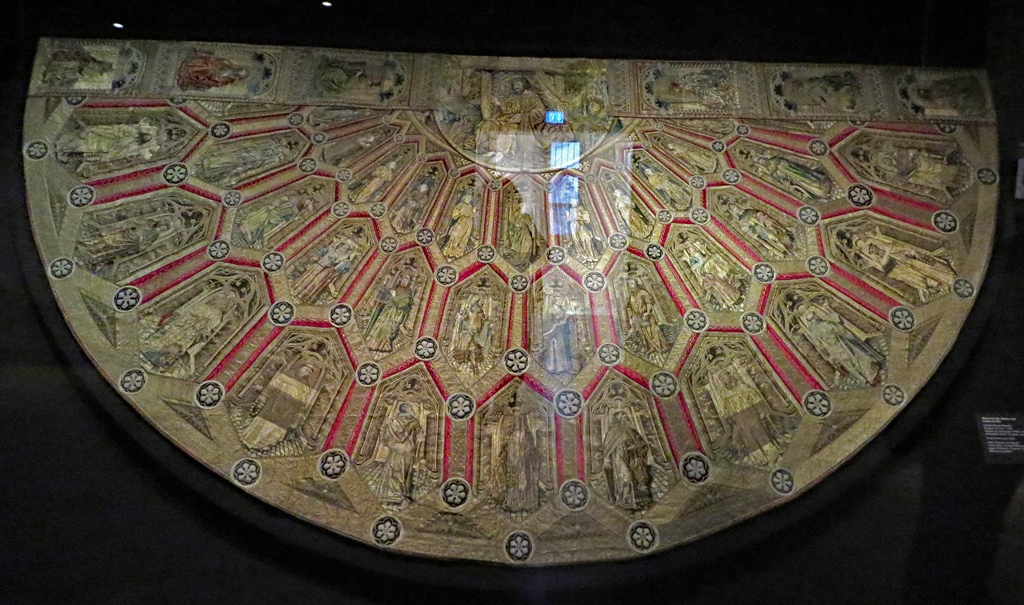
Cope of John the Baptist (Pluvial) (ca. 1425-40)
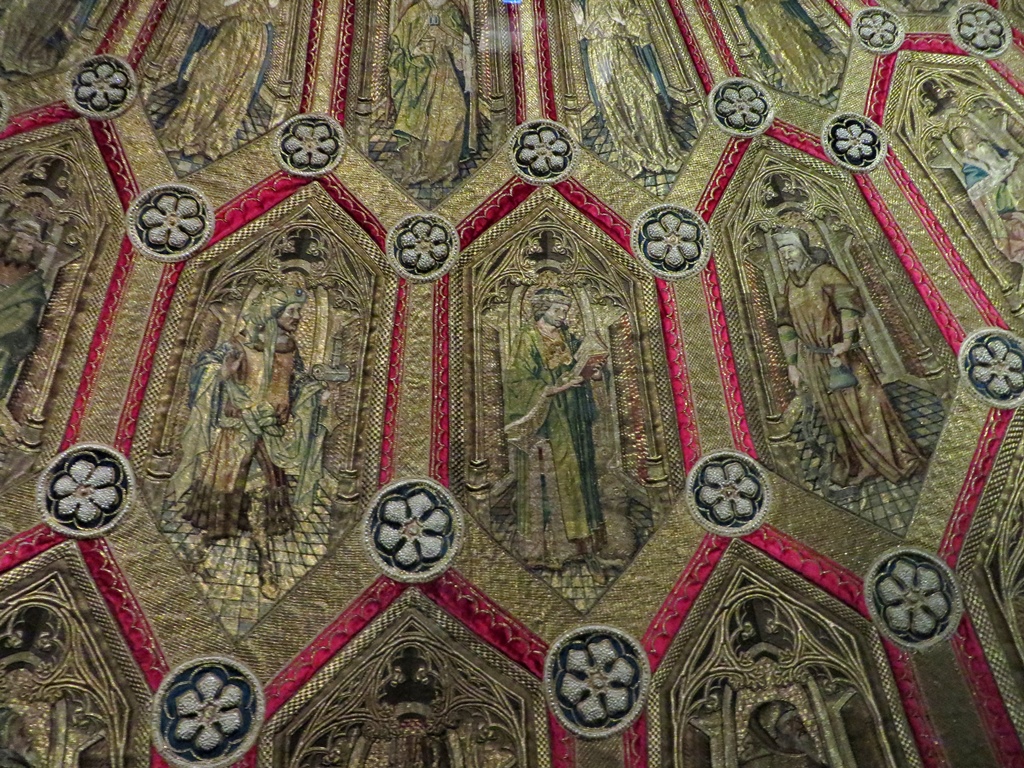
Cope of John the Baptist (detail)
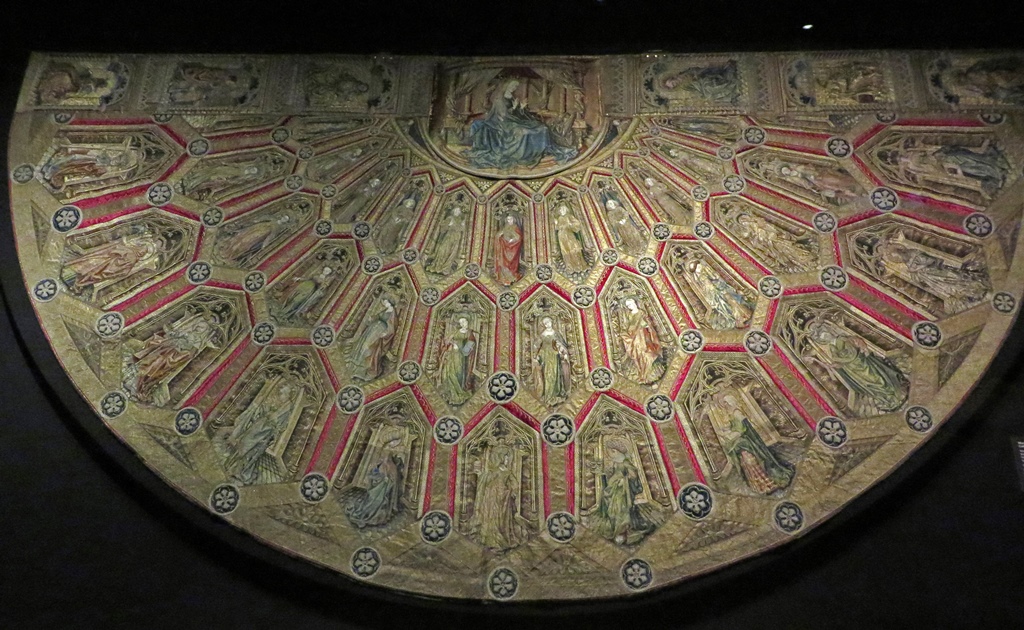
Cope of the Virgin (Pluvial) (ca. 1425-40)
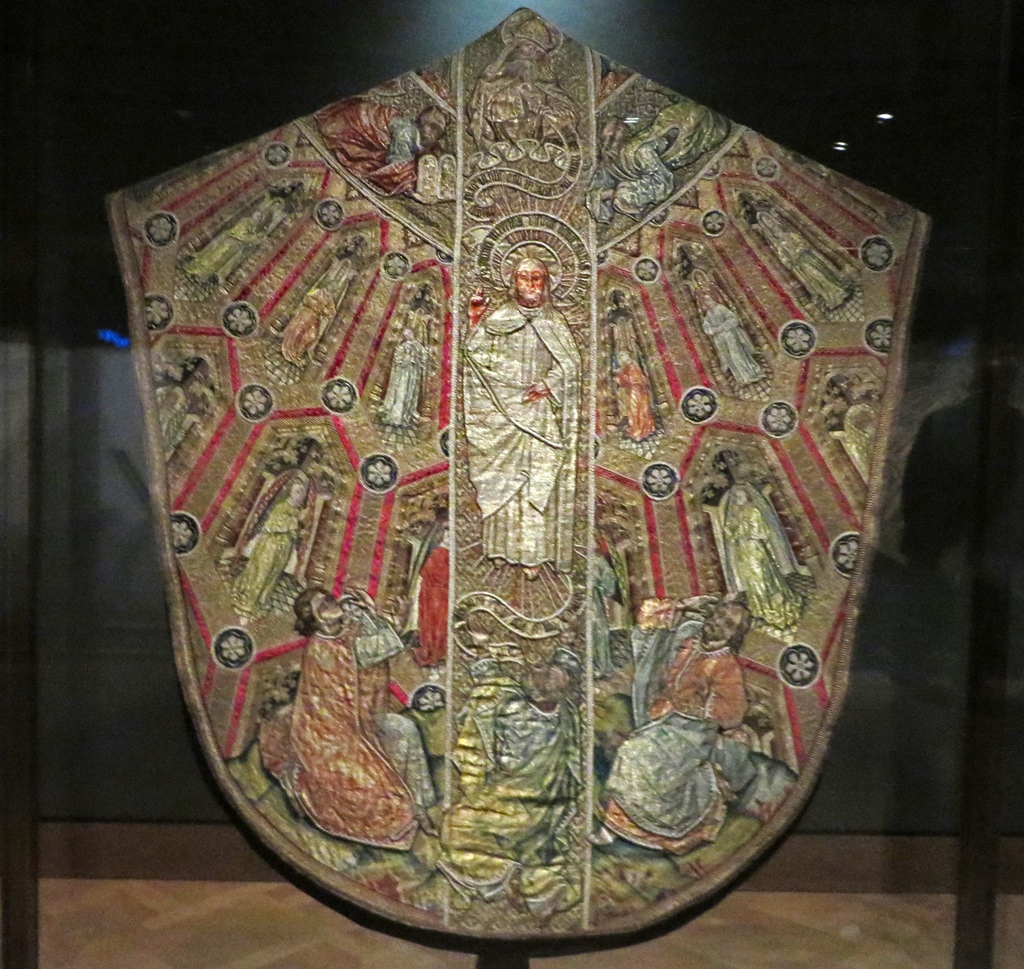
Casula (ca. 1425-40)
From the Schatzkammer we retraced our steps to In der Burg, which we exited
in the direction of the Neue Burg section of the palace complex. This took
us to a large square called the Heldenplatz, home to some equestrian statues
and enough space to pack in large numbers of Austrians to listen to
presentations, harangues or major announcements (e.g. Hitler announcing the
Anschluss in 1938).
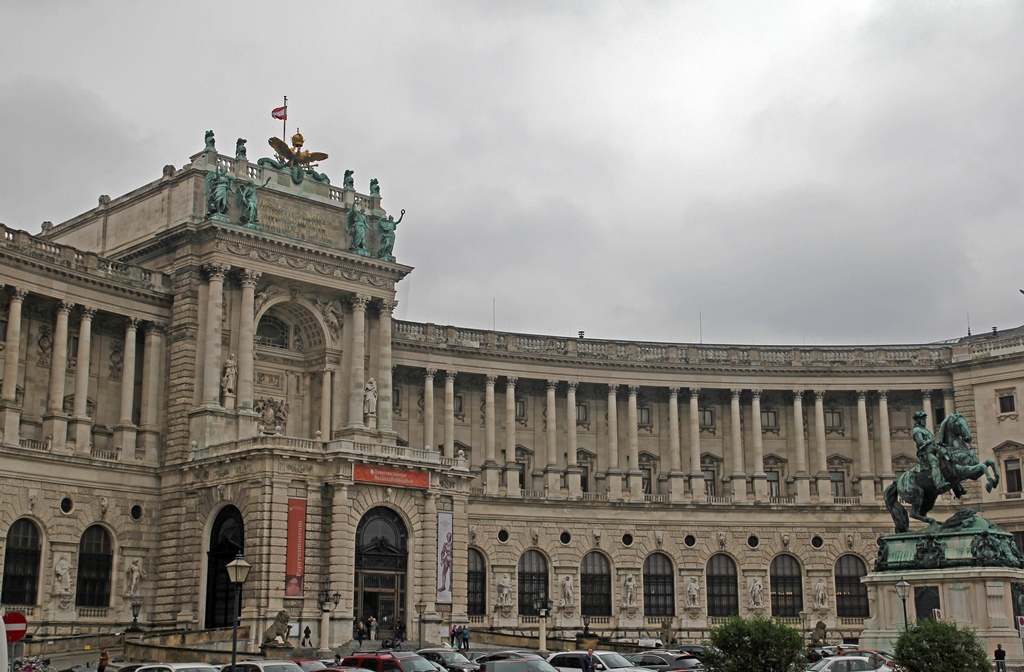
Neue Burg from Heldenplatz
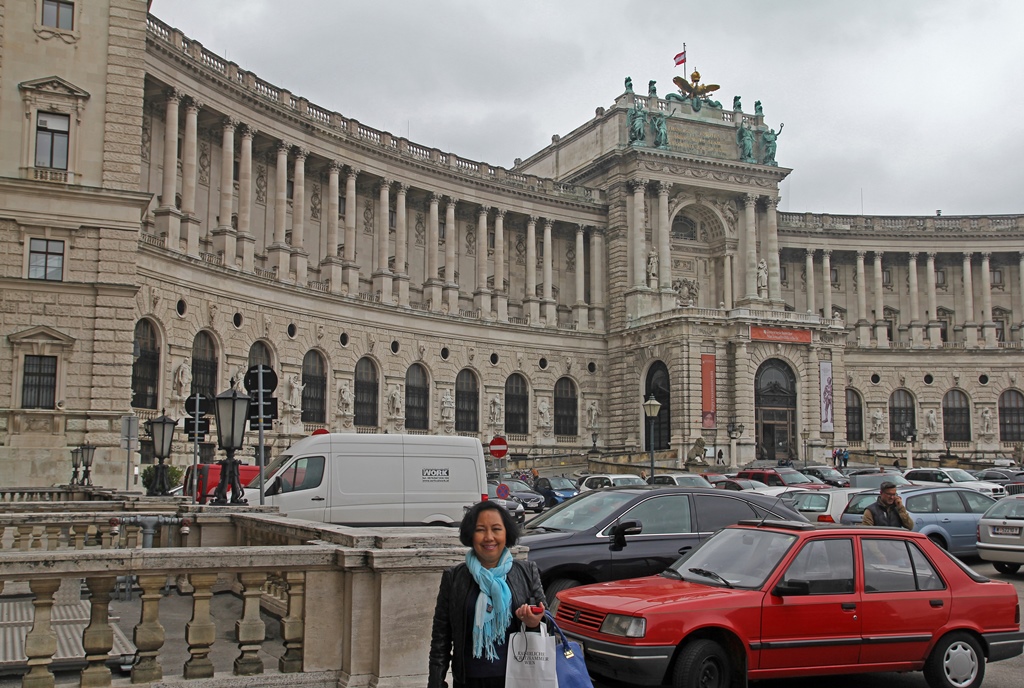
Nella and Neue Burg
Turning right, the Heldenplatz becomes a nicely maintained garden called the
Volksgarten. The Volksgarten contains what you would expect in a palace
garden, including manicured shrubbery, ponds, fountains and statuary. This
garden also has a monument to the Empress Elisabeth.
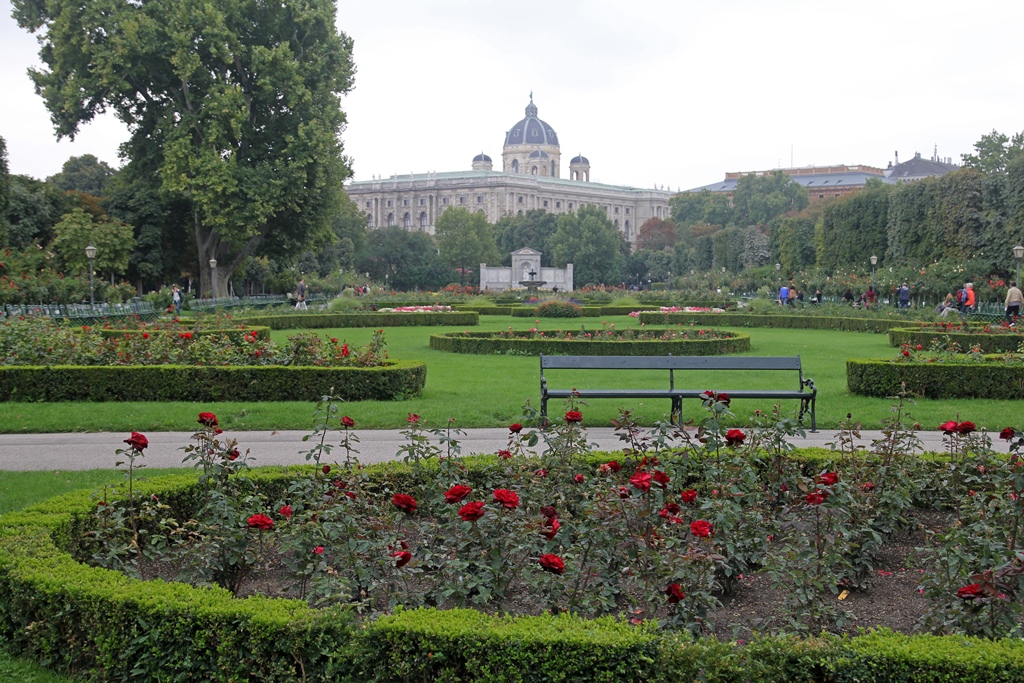
Natural History Museum from Volksgarten
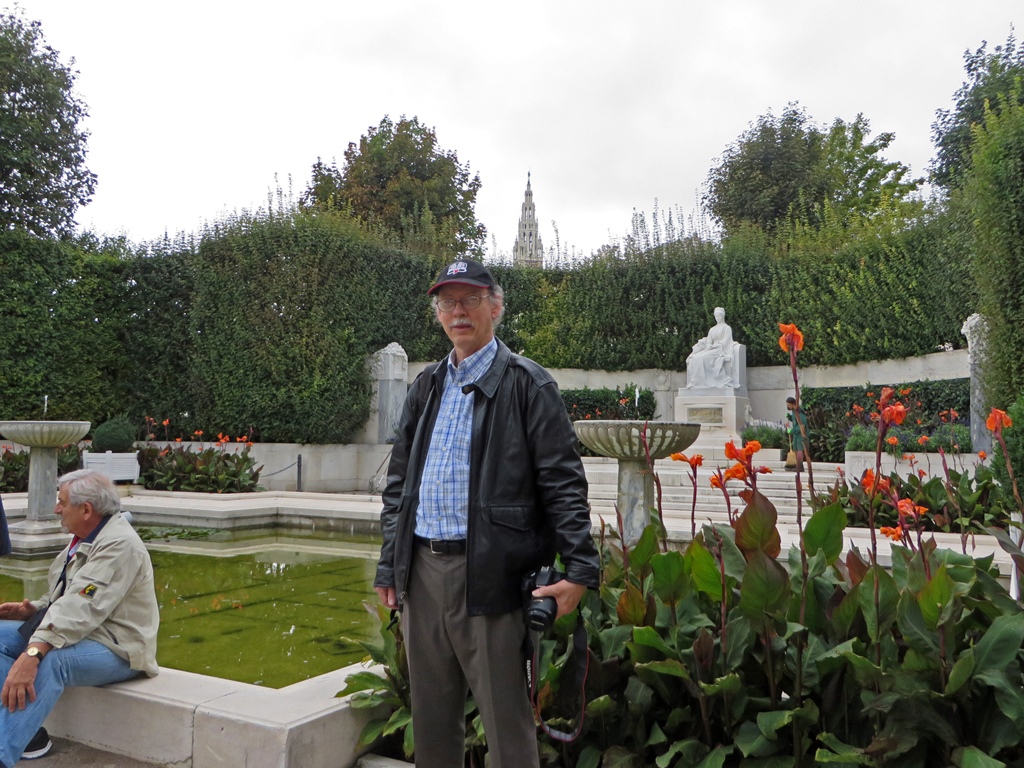
Bob and Empress Elisabeth Monument
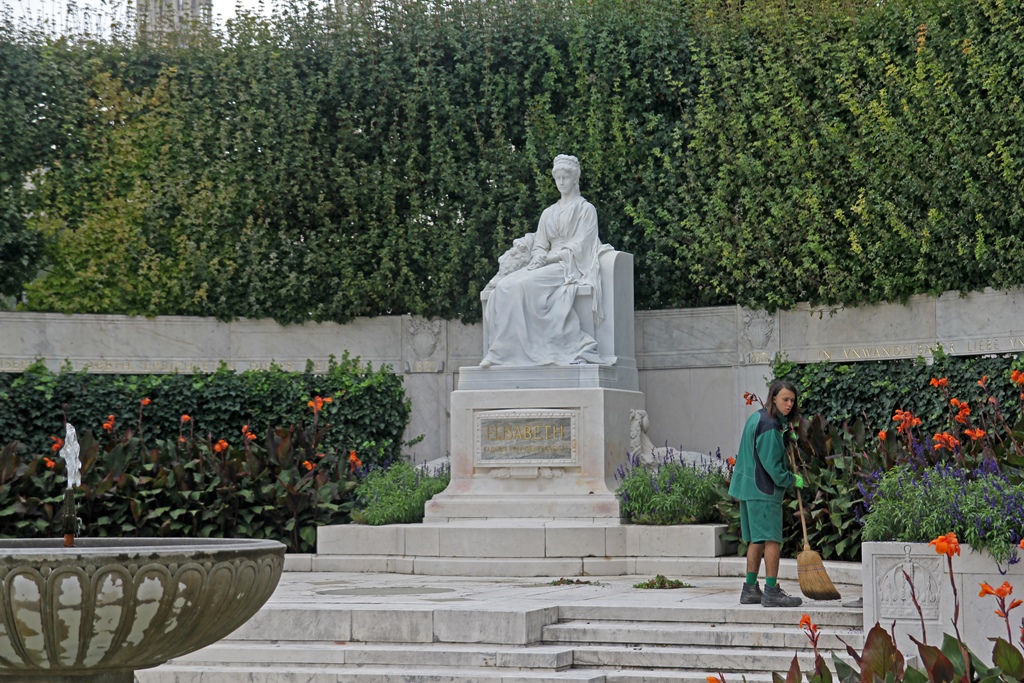
Empress Elisabeth Monument
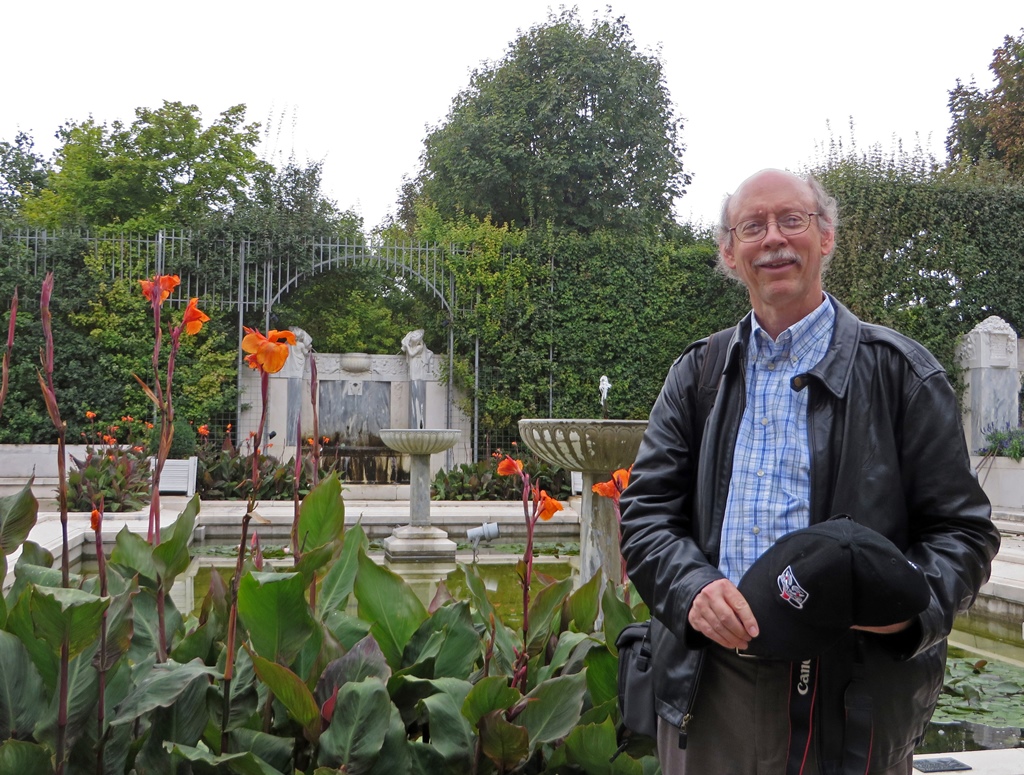
Bob and Pond
Continuing past the Volksgarten, we reached the Ringstrasse, which we
followed for a while, taking in some of the sights. There was the Rathaus,
or city hall (there was construction going on in front of it), a theater building
(the Burgtheater), a Parliament building, a university, and a nice-looking
church called the Votivkirche (also undergoing construction work). There
were also trams that followed the Ringstrasse.
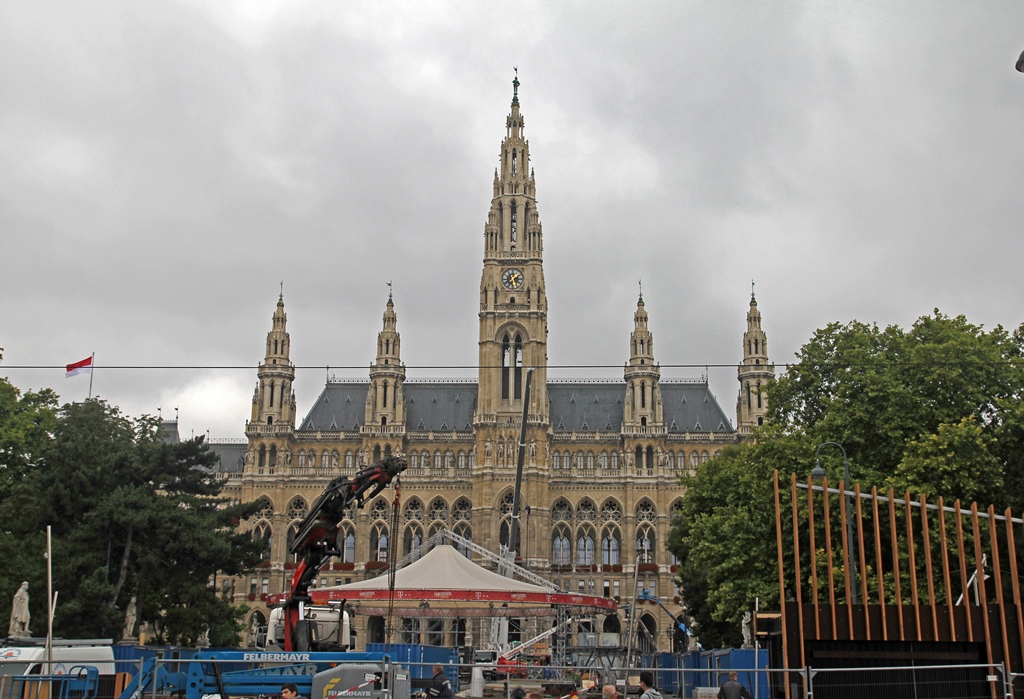
Rathaus
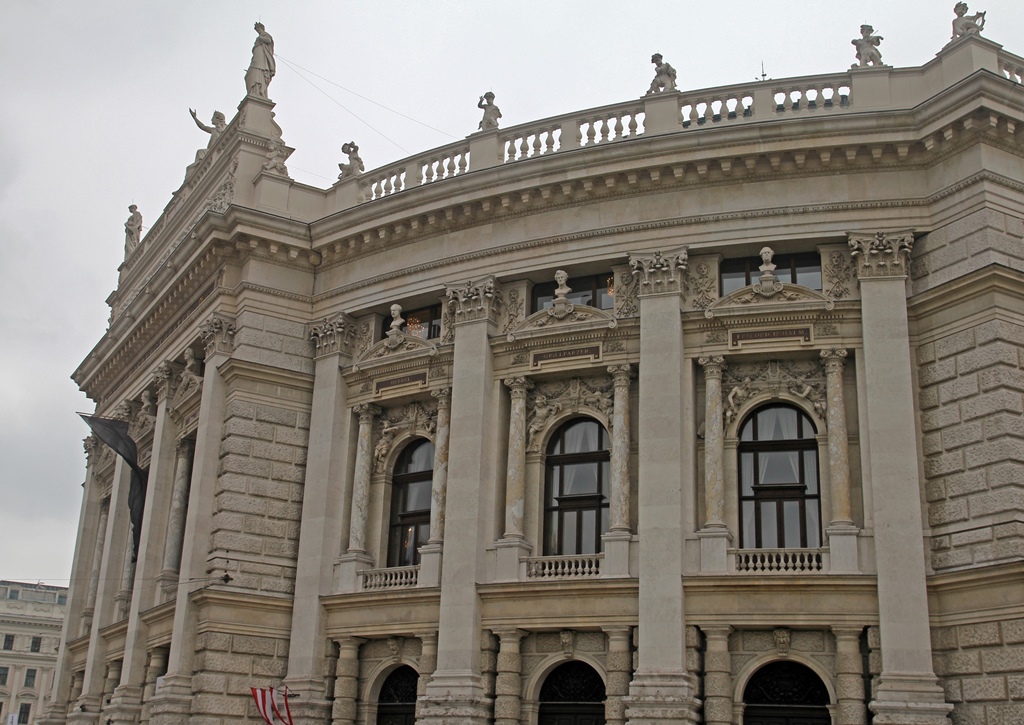
Burgtheater
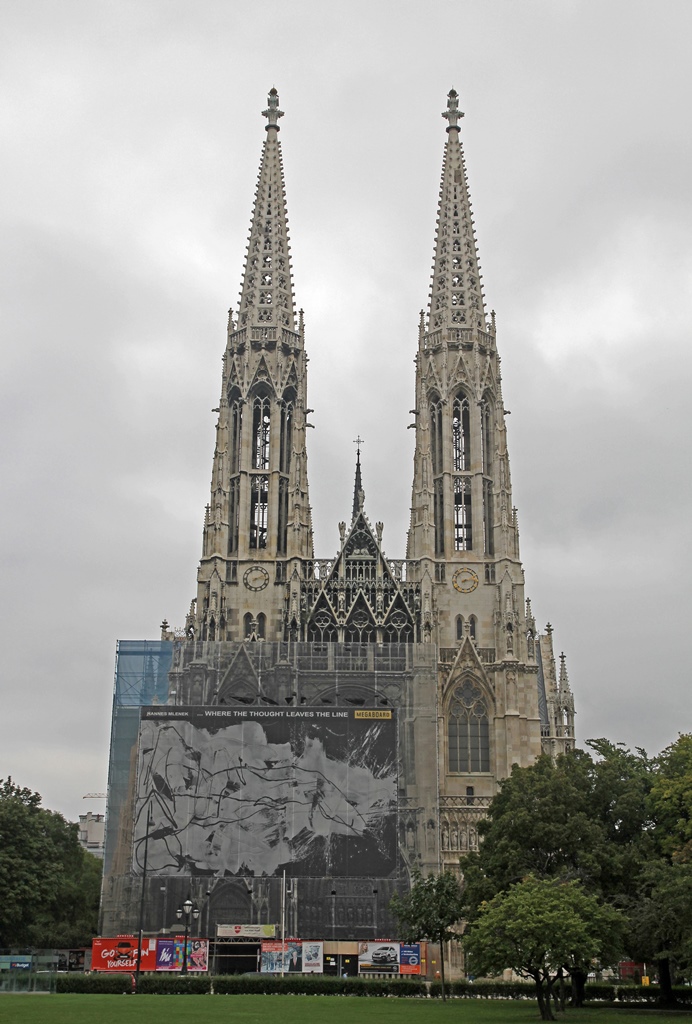
Votivkirche
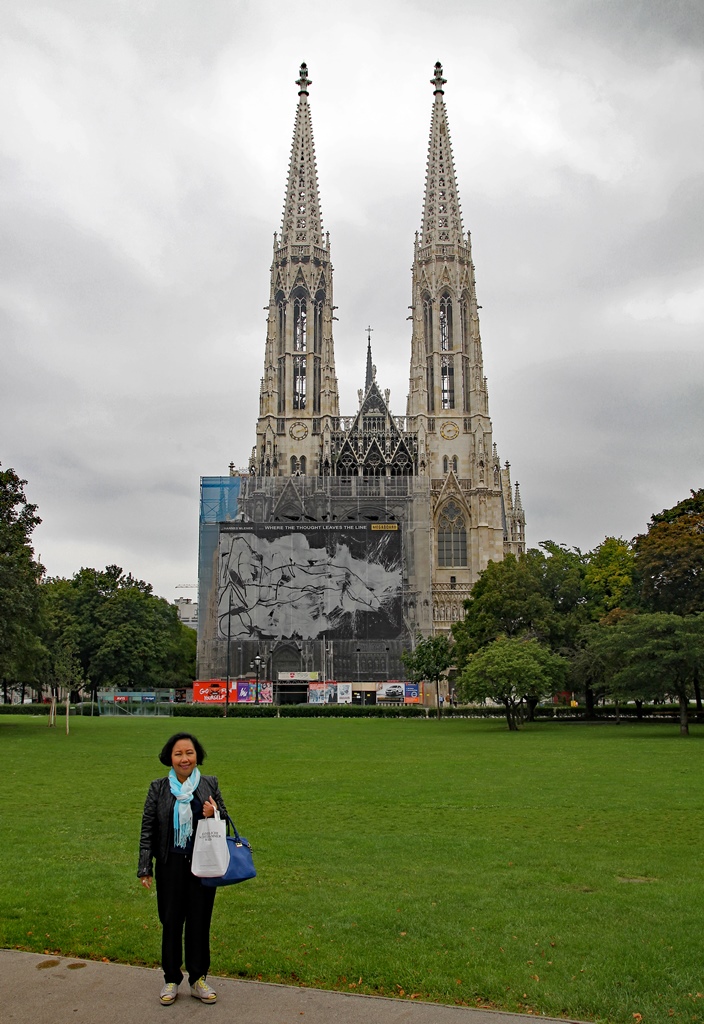
Nella and Votivkirche
Streetcar Stop on Ringstrasse
We were interested in heading to the next sight we were planning for the
day, but the trams didn't go there. Instead, we found an U-Bahn (subway)
station and a train that took us back into the Old Town, to St. Stephen's
Cathedral - the Stephansdom.
















